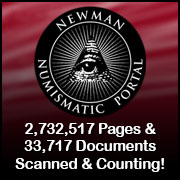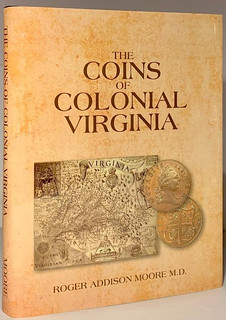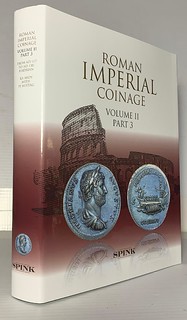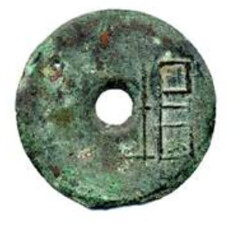
About UsThe Numismatic Bibliomania Society is a non-profit association devoted to the study and enjoyment of numismatic literature. For more information please see our web site at coinbooks.org SubscriptionsThose wishing to become new E-Sylum subscribers (or wishing to Unsubscribe) can go to the following web page link MembershipThere is a membership application available on the web site Membership Application To join, print the application and return it with your check to the address printed on the application. Print/Digital membership is $40 to addresses in the U.S., and $60 elsewhere. A digital-only membership is available for $25. For those without web access, write to: Charles Heck, Treasurer
AsylumFor Asylum mailing address changes and other membership questions, contact Chuck at this email address: treasurer@coinbooks.org SubmissionsTo submit items for publication in The E-Sylum, write to the Editor at this address: whomren@gmail.com BUY THE BOOK BEFORE THE COINSale CalendarWatch here for updates!
|
- WAYNE'S WORDS: THE E-SYLUM NOVEMBER 13, 2019
- DAVIS NUMISMATIC LITERATURE AT BALTIMORE EXPO
- NEW BOOK: THE COINS OF COLONIAL VIRGINIA
- BOOK REVIEW: NUMISMATICA GENEVENSIS SALES 11-12
- AUTHOR: WHY I WROTE 'IN GOD WE TRUST'
- HIGH DEMAND FOR 2020 RED BOOK
- VIDEO: SECRET OF THE GOOD SAMARITAN SHILLING
- VIDEO: WORLD NUMISMATICS AT USMEX 2019
- NUMISMATIC BURGLARIES: BRESSETT, TOULEMONDE
- READER THOUGHTS ON OBVERSE AND REVERSE
- MORE ON TELL-A-COIN GUIDE WHEELS
- NOTES FROM E-SYLUM READERS: NOVEMBER 10, 2019
- TOOLS FOR THE HUB COIN HOLDERS OFFERED
- VIC MASON'S THOUGHTS ON U.S. MINT FORUM
- U.S. MINT SEEKS TWO MEDALLIC ARTISTS
- 1921 SILVER DOLLAR ACT GAINS SPONSORS
- VOCABULARY TERMS: GOLDPLATE, GOLDPLATING, PART 1
- CHARLES T. GRAY (1807-1875)
- THE COLLECTION OF WILLIAM SPOHN BAKER
- NUMISMATIC AUCTIONS LLC SALE 64
- NUMISMATIC NUGGETS: NOVEMBER 10, 2019
- NUMISMATICS IN LIBERIA
- OPINION: TOO MANY CHALLENGE COINS
- 1864 GOLD NOTRE DAME RESTORATION MEDAL OFFERED
- SAVING CANADA'S VICTORIA CROSSES
- HOW TO STORE AND CARE FOR BOOKS SAFELY
- LOOSE CHANGE: NOVEMBER 10, 2019
- KING GEORGE III STATUE PART FOUND
Click here to access the complete archive
To comment or submit articles, reply to whomren@gmail.com
Content presented in The E-Sylum is not necessarily researched or independently fact-checked, and views expressed do not necessarily represent those of the Numismatic Bibliomania Society.
WAYNE'S WORDS: THE E-SYLUM NOVEMBER 13, 2019
 This week we open with a report from numismatic literature dealer Charlie Davis, one new book, a review, updates from Whitman Publishing and the Newman Numismatic
Portal, plus some great feedback from E-Sylum readers.
This week we open with a report from numismatic literature dealer Charlie Davis, one new book, a review, updates from Whitman Publishing and the Newman Numismatic
Portal, plus some great feedback from E-Sylum readers.
Other topics this week include the Hub Coin Holders, the U.S. Mint, the 1921 Silver Dollar Commemorative Coin Act, reverse goldplating, the numismatics of Liberia, challenge coins, Victoria Cross medals, and the Capped Bust half dollar.
To learn more about the coins of colonial Virginia, the Good Samaritan Shilling, "cross or pile", binoculars on the Mint tour, "W" mintmarks, copper spots on gold, the Washington medal collection of William S. Baker, Spade & Knife Money, the Palmetto medal, and eating banknotes with a side of sunflowers, read on. Have a great week, everyone!
Wayne Homren
Editor, The E-Sylum
DAVIS NUMISMATIC LITERATURE AT BALTIMORE EXPO
Numismatic literature dealer Charlie Davis writes:"I will have my usual tables (963-965) at the Whitman Baltimore show which also doubles as the 25th convention of the Colonial Coin Collectors Club. In addition to Roger Moore's new title on the coins of colonial Virginia, and the just-published Roman Imperial Coins II.3, I will have for sale an unprecedented offering of 11 original copies of Crosby's Early Coins of America."
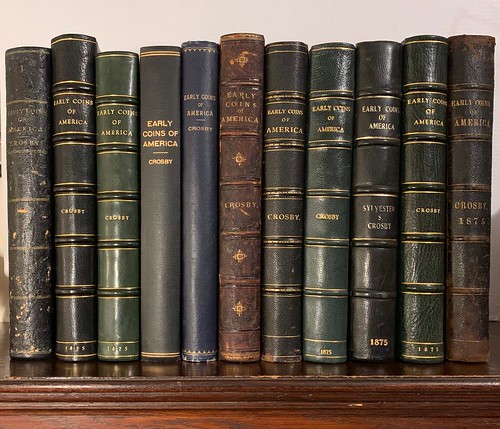
Be sure to stop by Charlie's table. I'll probably be there myself sometime Friday afternoon. -Editor
To visit the Charles Davis Numismatic Literature web site, see:
https://www.numisbook.com/
NEW BOOK: THE COINS OF COLONIAL VIRGINIA
Roger Moore has written a new book on the coins of colonial Virginia, published by the Colonial Coins Collectors Club. Congratulations! -Editor
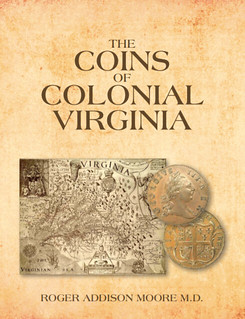 The Coins of Colonial
Virginia by Roger A. Moore MD, will fill a void in our understanding of both the 1773 copper halfpence of Virginia and the methods the Virginia colonists used to cope with the
scarcity of small change during the first 150 years of their existence. The growth and development of Virginia into one of the most important North American colonies can be traced
by the economic evolution of the Old Dominion State, as it attempted to gain the necessary hard currency needed for commerce.
The Coins of Colonial
Virginia by Roger A. Moore MD, will fill a void in our understanding of both the 1773 copper halfpence of Virginia and the methods the Virginia colonists used to cope with the
scarcity of small change during the first 150 years of their existence. The growth and development of Virginia into one of the most important North American colonies can be traced
by the economic evolution of the Old Dominion State, as it attempted to gain the necessary hard currency needed for commerce.
Equally as absorbing are the twists and turns encountered by the Virginia colonists as they sought and finally obtained authorization from the English Crown for their own coinage. It is ironic that the long desired copper Virginia halfpence of 1773, provided under Warrant from King George III, became available to the colonists only fifty days before the beginning of the American Revolution.
Specifics concerning how the copper for minting the coins was obtained based on contemporary letters from the procurer, the making of the matrixes, punches, and dies by the Tower mint engravers based on preserved minting tools and records at the Royal Mint Museum, and the processes for minting and for determining the quality evaluation of the minting based on documents in the British National Archives are all provided in detail.
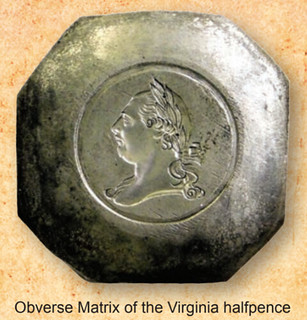 In spite of considerable time
spent on the history of Virginia's early development, the primary aim of the book is an in-depth exploration of the 1773 Virginia halfpence as collectable coins. The Coins of
Colonial Virginia provides thorough guides which allow the collector to attribute and differentiate each halfpenny variety. This is no small task since attributing this series
of colonial coins has notoriously been described as one of the most difficult numismatic tasks. Much attention has been directed at methods for facilitating the identification
process. Large high quality, color, photographic images of each obverse and reverse are provided with details of existing die states.
In spite of considerable time
spent on the history of Virginia's early development, the primary aim of the book is an in-depth exploration of the 1773 Virginia halfpence as collectable coins. The Coins of
Colonial Virginia provides thorough guides which allow the collector to attribute and differentiate each halfpenny variety. This is no small task since attributing this series
of colonial coins has notoriously been described as one of the most difficult numismatic tasks. Much attention has been directed at methods for facilitating the identification
process. Large high quality, color, photographic images of each obverse and reverse are provided with details of existing die states.
Another very comprehensive chapter uses photographs which show the myriad of Virginia halfpence fakes, facsimiles and fantasies. The author points out that eBay buyers are fooled by these fakes almost weekly. Other chapters deal with the metrology, the oddities, the rarity, and the grading of Virginia halfpence. Finally, the book is well written and indexed, while having an extensive bibliography for those wishing to further their knowledge about this colonial coinage.
The Coins of Colonial Virginia contains something for anyone interested in knowing how a long sought after colonial coinage finally came into being; how it was distributed and circulated; and most importantly how it can be collected in modern times. It is also a most enjoyable and educational read for all history enthusiasts.
The Coins of Colonial Virginia is a 318 page hardcover book with a dust cover and extensive color photographs. Its publication was supported by the Colonial Coin Collectors Club. With an ISBN: #978-1-64606-131-0, the book sells for $95. It is available directly from numismatic literature dealer Charles Davis, Telephone: (978) 468–2933, E-mail: numislit@aol.com.
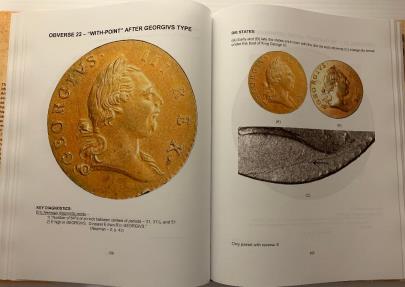
About the Author
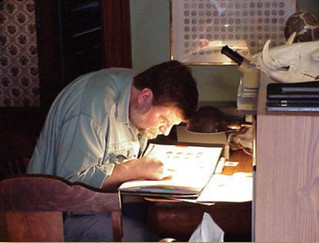 ROGER ADDISON MOORE began his interests in
numismatics at the age of five when he received a partially filled Whitman Lincoln Penny board from his grandfather. By nine he was exchanging twenty dollars in rolled coins from
his bank each Friday and going through them to improve and expand his collection, which eventually spanned all federal coinages.
ROGER ADDISON MOORE began his interests in
numismatics at the age of five when he received a partially filled Whitman Lincoln Penny board from his grandfather. By nine he was exchanging twenty dollars in rolled coins from
his bank each Friday and going through them to improve and expand his collection, which eventually spanned all federal coinages.
In his 40's he developed an interest in colonial coins, with his first variety being a New Jersey State copper. His collecting then expanded to Virginia halfpence, Saint Patrick halfpence and farthings, Mexican copper maravedis from the 1500s, various colonial currencies, British and Irish farthings and halfpence from the 1700s, colonial numismatic literature, and continues to grow into multiple other diverse numismatic areas.
He is a life member of the Colonial Coin Collectors Club in which he served as a past Treasurer. He is a member of the American Numismatic Association and the American Numismatic Society. He has written over 70 numismatic papers on a wide range of subjects and has previously contributed to and edited four numismatic books.
Roger was born in Portsmouth, Virginia, into a Navy family. The family moved every few years and therefore he was exposed to many new cities and states. He matriculated at Yale University for his undergraduate education, went on to the University of Virginia for medical school, had an internship and residence in pediatrics at the University of Colorado, a residency in anesthesia at the University of Pennsylvania and a fellowship in pediatric anesthesia and intensive care at Children's Hospital of Philadelphia. He has served as president of the New Jersey State Society of Anesthesiologists, the Society of Cardiovascular Anesthesiologists, and the American Society of Anesthesiologists. He presently serves as a Professor of Anesthesia and Critical Care at the Hospital of the University of Pennsylvania.
Jonni Lou is his wife of 43 years. Ashley, Sam, James, Julie and his grandchildren, Sammy and Josie round out his family.
For more information, or to order, see:
Moore: The Coins of Colonial Virginia
(https://www.vcoins.com/en/stores/charles_davis/44/
product/moore_the_coins_of_colonial_virginia/1211762/Default.aspx)

BOOK REVIEW: NUMISMATICA GENEVENSIS SALES 11-12
Last week we discussed a group of Zodiac mohurs and a very interesting silver bar from the reign of Tutankhamun offered by Numismatica Genevensis SA. In her email Newsletter #134 dealer Shanna Schmidt provides a capsule review of the sale catalogs. With permission we're republishing an excerpt here. -Editor
NGSA (Live floor auction in Geneva, 18 Nov)
NGSA typically has auctions every two years in the beautiful Hôtel Le Richemond in picturesque Geneva. Dr. Alain Baron puts on what I would term “an event” rather than a coin auction, which is not to be missed. It might be one of the most sophisticated of sales that the coin world has. His catalogs are all hard bound and feature some of the most impressive coins available on the market. Many of the coins are outside of my area of expertise but it doesn't take an expert to see that he is able to persuade many high brow collectors to consign and buy in his auctions. This sale is no different. Two catalogs are being presented.
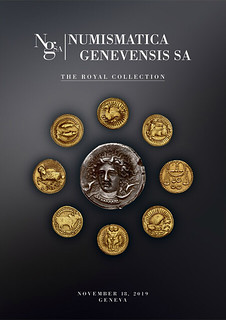
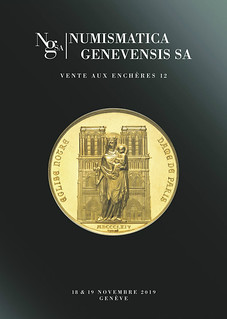
The first is “A Royal Collection”. The first coin might be one of the most beautiful Greek coins ever created. It is a silver tetradrachm signed by Kimon. The starting price however is already at a whopping 1.5 million CHF. (This coin last sold for 2.3 million CHF in a 2014 NAC auction). Not many ancient coins reach that level so being in the room for this sale will be an amazing experience. A Royal Collection is a mere 47 lots but every coin is estimated in the 5 or 6 digits.
The second catalog, Auction 12, is far larger and with about 57 ancient coins. The first lot is an incredible silver lingot of Toutankhâmon. The historical significance of the piece is mind boggling. The starting price is 30,000 but I imagine it will go much higher. This sale has some equally fantastic ancient coins. If lot 1 in the “A Royal Collection” is too rich for you, there is another opportunity to obtain a signed Kimon tetradrachm of amazing beauty. Lot 112 is equally spectacular but at a fraction of the price (250,000 CHF starting). It has a pedigree going back to a 1993 Sotheby's-NFA sale.
In the Imperatorial section there is an exceedingly rare gold legionary aureus (Legion 20) of Marc Antony. Lot 148 is a large size gold piece, a “quaternio”, of the emperor Maxence. This piece comes out of a 1996 Christie's London auction. Finally lot 155 is a beautiful solidus of Anastasius I from Constantinople. This left facing beautiful portrait style is extremely rare. This coin comes from the Lacam collection of 1974 and was part of the Hunt collection which Sotheby's sold in 1990. The second part of the catalog has some dazzling Renaissance medals (lots 195-197).
To visit Shanna's web site, see:
https://www.shannaschmidt.com/
Lot 706 is a beautiful gold medal featuring the façade of Notre Dame. See the article later in this issue about the piece, the proceeds of which will be donated for the restoration of the cathedral.
Shanna has booth 1136 in the ancient/world section in this week's Whitman Baltimore Expo (November 14-17). Stop and say hello! -Editor
To read the earlier E-Sylum articles, see:
TUTANKHAMUN-ERA SILVER BAR OFFERED (https://www.coinbooks.org/v22/esylum_v22n44a22.html)
GOLD ZODIAC MOHURS OFFERED (https://www.coinbooks.org/v22/esylum_v22n44a25.html)
AUTHOR: WHY I WROTE 'IN GOD WE TRUST'
Dennis Tucker of Whitman Publications forwarded this article by author Bill Bierly on his new book, In God We Trust. Thanks. -Editor
In November 2019 Whitman Publishing will release In God We Trust: The American Civil War, Money, Banking, and Religion. The 352-page hardcover volume will be available from booksellers and hobby shops nationwide, and online (including at www.Whitman.com). Here, author William Bierly discusses his motivation in writing the book.
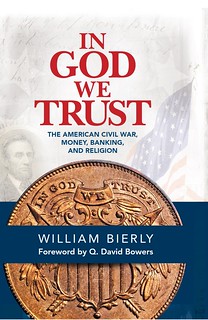 My book In God We Trust is an effort
to address different issues of the American Civil War than most histories do. Most deal with its military aspects, covering the battles and the generals. Others explore the
politics of the war. In God We Trust endeavors to illuminate two other angles.
My book In God We Trust is an effort
to address different issues of the American Civil War than most histories do. Most deal with its military aspects, covering the battles and the generals. Others explore the
politics of the war. In God We Trust endeavors to illuminate two other angles.
One is the conflict's religious, spiritual side, in which the Confederacy and the Union contested in an ideological struggle for what they viewed as “God's favor.” Which side was the more Christian, the more righteous, the holier one, and how could they demonstrate their greater holiness? Indeed, Abraham Lincoln discussed this in his second inaugural address. This struggle took various forms but included the Confederacy placing a religious reference in its new constitution, thus creating a contrast to the federal constitution, which was viewed as being “Godless.” The reactions to this in the North had various manifestations, one of which was the ultimate adoption of the motto “In God We Trust” on federal coinage.
The second aspect is the financial and monetary side of the war. This includes the larger picture of how the war was financed through taxes, tariffs, and the issuance of bonds and “greenbacks,” but also the issues of how ordinary people coped with everyday purchases during the coin shortages that developed during the war.
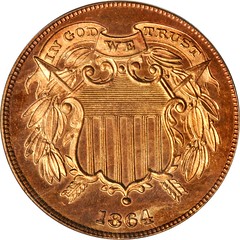
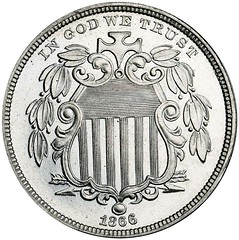
As the story unfolds, the spiritual and monetary issues come together with the motto “In God We Trust” on the coinage.
I recall a quote from the prolific numismatic writer Q. David Bowers, stating that “mainstream” history and coin collecting seldom intersect. From the collecting side the focus is on the coins themselves, often neglecting the historical context from which they emerged or which they in turn influenced. From the history side, coins are largely ignored, regarded as insignificant parts of the bigger story.
Bowers has cited his conversation with a noted history professor, an expert on the Civil War, who was completely unaware of Civil War tokens, issued during the war as a means to alleviate coin shortages and now a popular collectible among numismatists. By the professor being unaware of these tokens, Bowers realized he was missing a significant element of what everyday life was like during the war, of which the tokens were evidence. In a similar way, the pattern coins highlighted in my book are artifacts that illustrate and help tell the story of how “In God We Trust” came about.
The financial issues of the war led to significant changes in the monetary system of the United States. These include the introduction of a standardized national currency issued under federal authority, and the development of a national banking system. These greatly facilitated the United States in emerging as a modern industrial and financial power in the nineteenth and twentieth centuries.
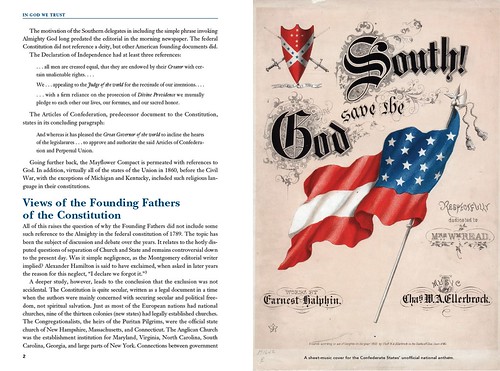
“In God We Trust” on U.S. coinage has grown into an iconic element of American culture. It has become in the years since the Civil War the official national motto of the United States. It has over the years excited both strong approval and strong opposition. Controversy surrounds it to the present day.
It is my hope that the discussion of these issues in my new book will provide the reader with a fuller understanding and deeper perspective on the Civil War. I also hope to impart a better understanding of how our money and banking systems came to be what they are.
In God We Trust: The American Civil War, Money, Banking, and Religion
By William Bierly; foreword by Q. David Bowers
ISBN 0794845282
Hardcover, 6 x 9 inches, 352 pages, full color
Retail $29.95 U.S.
For more information, or to order, see:
https://www.whitman.com/store/Inventory/Detail/In-God-We-Trust+0794845282
To read the earlier E-Sylum articles, see:
NEW BOOK: IN GOD WE TRUST (https://www.coinbooks.org/v22/esylum_v22n41a04.html)
BOOK PREVIEW: IN GOD WE TRUST (https://www.coinbooks.org/v22/esylum_v22n44a03.html)
HIGH DEMAND FOR 2020 RED BOOK
I expect Bill Bierly's In God We Trust to be a blockbuster among numismatic books published this year. It turns out that one of the longest-running books on U.S. coinage is a blockbuster as well - the Red Book is going into a Second Printing. Here's a press release from Whitman Publications, submitted by Dennis Tucker. -Editor
the Guide Book of United States Coins Back to Press
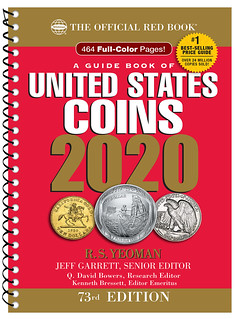
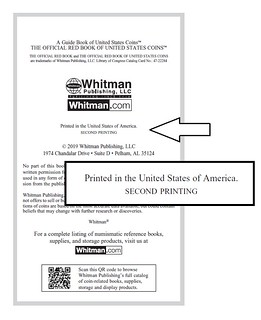
In a sign of the strength of the coin-collecting hobby, dramatically higher than usual demand has caused Whitman Publishing to go back to press with the spiralbound version of the Guide Book of United States Coins, 73rd edition.
The Guide Book, published since 1946 and popularly known as the “Red Book,” is the best-selling annual price guide for the coin-collecting hobby. More than 24 million copies have been sold since the first edition.
“We plan our print runs very carefully, benchmarking against previous years' sales,” said Whitman president Mary Burleson. “With years of data to analyze, we can control our inventory by printing to anticipated collector demand. This year's demand has unexpectedly been much stronger than normal. Not since 2006 have we had to go back to press to meet higher than expected demand.”
From casual hobbyists to longtime collectors and professional numismatists, Whitman estimates that coin collectors number in the millions nationwide. The American Numismatic Association, the country's largest hobbyist organization, has 25,000 active members.
“The Red Book is distributed nationally in bookstores and other retail locations, and online,” said Burleson. “The increased demand suggests to us that many new collectors and potential collectors have entered the market over the past year. This is a positive sign for the hobby.”
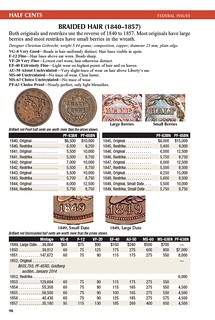
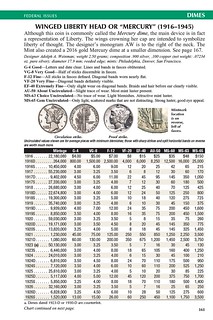
Whitman publisher Dennis Tucker said that many hobbyists acquire the Red Book as a collectible itself, seeking one of every edition. To help them identify books in their collections, Tucker noted, “The new press run of the spiralbound format has SECOND PRINTING on its copyright page.”
Collectors can check their local bookstore or hobby shop, or call Whitman's Customer Service number at 1-800-546-2995, to order a copy of the spiralbound Red Book for $15.95. Copies of the first printing will be shipped as long as it's in stock, and the second printing will be added to Whitman's inventory distribution when available.
A Guide Book of United States Coins, 73rd edition
464 pages
Full color
By R.S. Yeoman; senior editor Jeff Garrett; research editor Q. David Bowers;
editor emeritus Kenneth Bressett.
$15.95 convenient lay-flat spiralbound
$17.95 classic red hardcover
$19.95 spiralbound hardcover
$29.95 Large Print Edition
$49.95 expanded Deluxe Edition (1,504 pages)
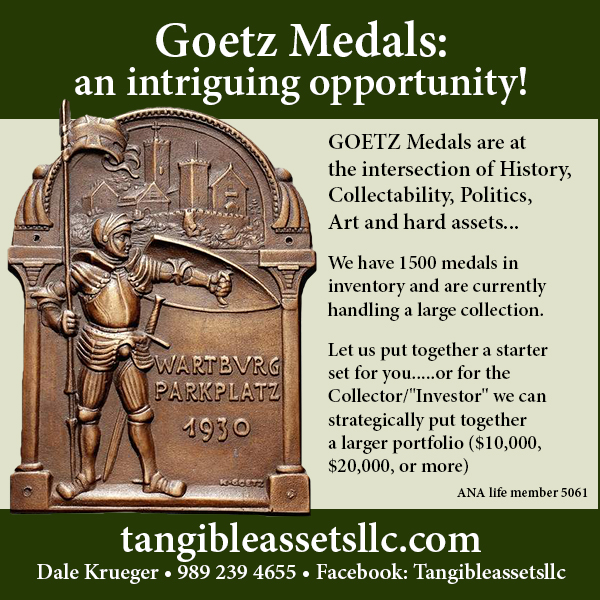
VIDEO: SECRET OF THE GOOD SAMARITAN SHILLING
The latest addition to the Newman Numismatic Portal is a new video about Eric Newman's research on the Good Samaritan Shilling. Project Coordinator Len Augsburger provided the following report. -Editor
Getting to Know Eric P. Newman, Part 1
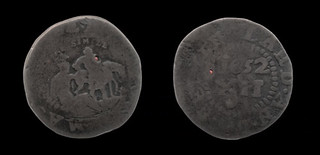 Lianna Spurrier is well-known to E-Sylum readers and has completed two video series for Newman Portal,
including same-day coverage of the 2019 World's Fair of Money and a group of videos aimed at young numismatists. Spurrier now starts a new video series focused on publications of
Eric P. Newman. The first entry focuses on Newman's 1959 work The Secret of the Good Samaritan Shilling. One of the most notorious fabrications in the history of American
numismatics, this piece sold for $650 in the Bushnell (1882) sale. By way of comparison a Birch cent from the same collection sold at $290. Newman demonstrated that the Good
Samaritan counterstamp on a Pine Tree shilling was not contemporary, and hoped that he would be a “Good Samaritan” in having set the record straight. The work combined Newman's
interest in colonial numismatics and expertise in counterfeit detection, and is neatly explicated in this new video by Spurrier.
Lianna Spurrier is well-known to E-Sylum readers and has completed two video series for Newman Portal,
including same-day coverage of the 2019 World's Fair of Money and a group of videos aimed at young numismatists. Spurrier now starts a new video series focused on publications of
Eric P. Newman. The first entry focuses on Newman's 1959 work The Secret of the Good Samaritan Shilling. One of the most notorious fabrications in the history of American
numismatics, this piece sold for $650 in the Bushnell (1882) sale. By way of comparison a Birch cent from the same collection sold at $290. Newman demonstrated that the Good
Samaritan counterstamp on a Pine Tree shilling was not contemporary, and hoped that he would be a “Good Samaritan” in having set the record straight. The work combined Newman's
interest in colonial numismatics and expertise in counterfeit detection, and is neatly explicated in this new video by Spurrier.
Image: The “Good Samaritan” counterstamp on a Noe-25 Pine Tree shilling
Link to Secret of the Good Samaritan Shilling video on NNP:
https://nnp.wustl.edu/library/book/570537
Link to Ford/Hamelberg copy of the Bushnell sale on NNP:
https://nnp.wustl.edu/library/auctionlots?AucCoId=21&AuctionId=510831
VIDEO: WORLD NUMISMATICS AT USMEX 2019
These are selections from the David Lisot Video Library that feature news and personalities from the world of coin collecting. David has been attending coin conventions since
1972 and began videotaping in 1985. The Newman Numismatic Portal now lists all David's videos on their website at:
https://nnp.wustl.edu/library/multimediadetail/522852
Here are some coins offered by the firm World Numismatics at the recent US Mexican Numismatic Association Coin Convention. -Editor
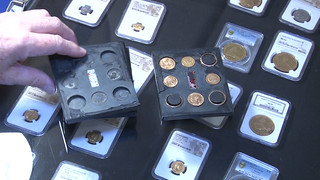 Patrick Richey, Partner, World
Numismatics, David Lisot, Interviewer, CoinTelevision.com.
Patrick Richey, Partner, World
Numismatics, David Lisot, Interviewer, CoinTelevision.com.
One of the sponsors of the US Mexican Numismatic Association Coin Convention is World Numismatics. Partner in the firm Patrick Richey shares some of the “cool coins” they have brought to sell at the show including a World War II Flying Kit with English Sovereign & half Sovereign, French 10 & 20 Franc and gold rings, 561 BC Lydia Gold Stater of King Croesus, and Roman Silver Denarius with Cleopatra and Marc Antony.
This video is a highlight from:
US Mexican Numismatic Association Convention Highlights 2019
An excerpt of the video is available for viewing on the Coin Television YouTube Channel at:
https://youtu.be/RZZqXFDLqLU
NUMISMATIC BURGLARIES: BRESSETT, TOULEMONDE
Numismatic burglaries occur far too often. In recent weeks two high-profile thefts have taken place; please be on the lookout for the stolen material. -Editor
Below is an updated list of stolen items taken during the residential burglary of Professional Numismatist Ken Bressett in Colorado Springs, CO. The offense occurred on 11/2/2019.
- Several pieces of spade, knife, Key and other early types.
- Approximately 20 sycee, various sizes and shapes.
- 1923 P'u Yi marriage dollar. Uncirculated.
- 1928 Kweichow Province automobile dollar EF.
- 1934 Communist dollar. AU.
- 1943 Yunnan-Burma Tael.
- 25 or more Blue Whitman coin boxes, each containing about 60 Chinese cash coins all in individual envelopes and identified with Schjöth numbers. Values range from about $3 to $500 + each.
- 30 pieces of multiple copper square-hole cash.
- Several Whitman boxes of coins from Japan, India, Korea, Annam and other place.
- Type set of Fractional Currency. Mostly CU condition.
- U. S. Type set of various coins 1c to 50c. Many EF-AU. 1820 1c Unc, 1854 ½ c Unc., 1794 cent, etc. Some fractional gold; hobo 5c by Ron Landis; Admiral Vernon medals; Love tokens.
- 1976 Uncirculated Canadian Olympic coins, missing the $5.00 Javelin coin that was left behind.
- Gold Bulova watch c.1945 vintage.
- Gold chain with ancient Byzantine bronze cross.
- Three large gold man's rings set with ancient carnelian seal-stones.
- Various items of ladies' jewelry, earrings, bracelets, etc.
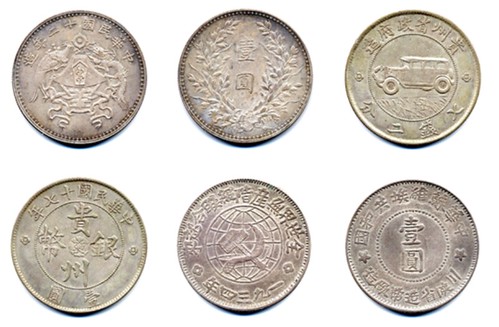
Thanks to Len Augsburger, Carl Wolf and others who forwarded the information from the Numismatic Crime Information Center. Ken Bressett is in our hearts and minds today - this could have happened to any one of us, and the loss of numismatic material is heartbreaking.
Here's another high-profile theft: Alan Luedeking forwarded this communiqué from Colombia. -Editor
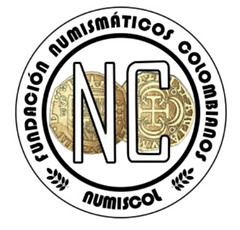 The Fundación
Numismáticos Colombianos (NUMISCOL) is grieved to inform the public that a priceless treasure of Colombian numismatics has been stolen. A band of robbers assaulted the apartment
of Mr. Gregorio Toulemonde and besides his possessions, made off with a collection of Colombian silver and copper coins of incalculable value painstakingly assembled over a more
than 50-year period. For more information please contact Mr. Toulemonde at prensa@numiscol.com or via WhatsApp at +57.302.234.5170.
The Fundación
Numismáticos Colombianos (NUMISCOL) is grieved to inform the public that a priceless treasure of Colombian numismatics has been stolen. A band of robbers assaulted the apartment
of Mr. Gregorio Toulemonde and besides his possessions, made off with a collection of Colombian silver and copper coins of incalculable value painstakingly assembled over a more
than 50-year period. For more information please contact Mr. Toulemonde at prensa@numiscol.com or via WhatsApp at +57.302.234.5170.
Here is a preliminary list of the items stolen, and should any of these items surface, the numismatic community is asked to please abstain from purchasing any of them and instead notify Mr. Toulemonde immediately:
- 1/2 Real 1760 Nuevo Reino pillar coin (only known example in private hands)
- 1 Real of 1760 Nuevo Reino pillar coin (extremely rare.)
- 1 Centavo coins: Complete 20th Century collection (all known issues; 66 coins)
- 2 Centavos coins: Complete 20th Century collection (all known issues including the extremely rare 1922; 28 coins)
- 1/4 Décimo and 1/4 Real pieces: Complete collection of all known issues, including the rare 2-1/2 Centavo Lazareto issue; 130 pieces)
- 1/2 Décimoand 5 Centavo coins: all known issues through 1878 (complete collection missing only the two pieces of Medellín of 1870; 188 coins).
- 1 Décimo, 1 Real and 10 Centavos coins: complete collection 1760 through 1978; 165 pieces.
- 2 Décimos, 2 Reales and 20 Centavos coins: virtually complete collection 1772 through 1979; 157 pieces.
- 5 Décimos and 50 Centavos coins: all issues including the half peso of Medellín, 1868 to 1980; 153 coins.
- Many other rare coins; however the crown-size 1 Peso coins were not stolen.
A more detailed list by dates will be released soon.
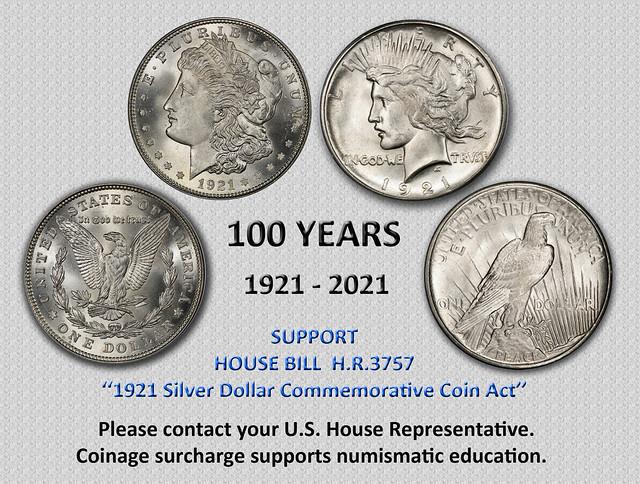
READER THOUGHTS ON OBVERSE AND REVERSE
Last week we kicked off a discussion of how to define the obverse and reverse of a coin. -Editor
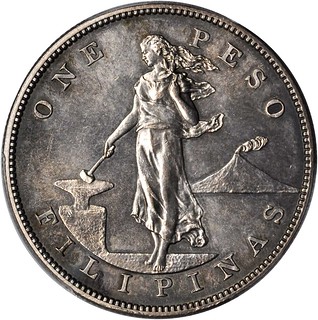
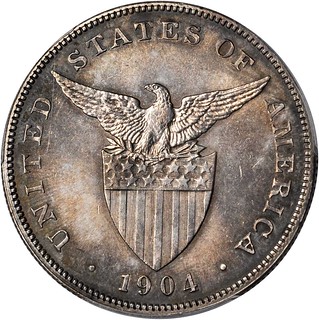
Martin Purdy of Upper Hutt, New Zealand writes:
Telling obverse from reverse should be easy in theory - just find out which design was on the lower die and that's the obverse, the upper die being the reverse! But then, getting that info out of all the world's mints isn't going to be all that straightforward, and I'm sure I've seen a video of certain coins being struck sideways, which does away with any notion of upper and lower in those cases anyway.
It really does vary from series to series. In any monarchical system with a royal effigy on one side, it's easy because that's going to be the obverse. But (there's always a but), the principle with NZ-issued tokens is that the name of the issuer appears on the obverse, so in instances where the issuers included an image of the Queen or Prince Albert on their tokens, the royal image is actually the reverse (the logic being these aren't regal coinage and therefore not issued in the name of the Queen, so the royal image is secondary to the name of the issuer).
And in the Japanese series, the definition of which side was obverse and which was reverse was swapped over in 1875, in mid-series, with no change in design. I have never found out why. Maybe they swapped the position of the upper and lower dies?
So, all flippancy aside, each issuing entity seems to have its own principles. I recently read a series of articles in Ursula Kampmann's CoinsWeekly on German circulating coins, and the attribution of obverse and reverse accompanying the photos was the opposite of what I had been assuming for the previous 45 years or so. Never too late to learn, I guess.
John Phipps writes:
I think the obverse/reverse question just scratches the surface of USPI coin questions. In 2015, I was a first time exhibitor at the ANA World's Fair of Money Show. My exhibit was about the confusion associated with the 1936 Commemorative Issues. The starting premise was that as I looked for these coins at shows, many dealers would offer 1947 MacArthur commemorative coins or 1920 Wilson Mint Opening medals. As I worked on the exhibit I found much more confusion!
My first struggle was which class to mark on the exhibit application. Should it be in "Class 1: US Coins" or "Class 14: Numismatics of Asia & the Pacific." The best suggestion I got on that question was to enter the exhibit in Class 14 because there would be fewer entries and a better chance of being recognized with an award.
The second questions was which side is the obverse and the reverse? This is important as the ANA judges are taught to be critical and "errors" reduce the points awarded to the exhibit. I consulted a number of books and even called two noted Philippine numismatists on the phone. I found four very unclear answers, 1) "the obverse is the side with the human image," 2) "the obverse is the side with the date," 3) "the reverse is the side with the denomination" and 4) "the obverse is the side that the hammer die strikes." One and three are in conflict with two and I never did figure out which "side the hammer die struck." So I added some text to my exhibit on this confusion.
The third question was whether the "Mint of the Philippine Islands" is a branch of the US Mint or not? Most written reference sources say that it was a branch mint. But the facts make a very strong and clear case that this mint was not a branch mint. In my investigation of this question I also asked why USPI coins are not included in "Major US Type Set" albums and folders. The clearest answer I got on that was from Ken Bressett. He said, "We just don't think of those coins that way."
I don't think that these questions ever will have universally accepted answers. But my exhibit got Third Place in Class 14 so I was very happy to have this confusion in the hobby.
Great questions often lead only to more questions. Interesting topic! I wasn't aware of the tie to the die. Where did that tradition start? -Editor
Martin adds:
There's a variant on "heads or tails" that uses "cross or pile" instead - the cross being the standard reverse on most European silver pennies/deniers in the Middle Ages, and pile being the name for the fixed lower die. That makes the upper die, or trussel - the one that was hit with the hammer in those days - the reverse, which conflicts with Mr. Phipps' fourth definition.
Even these definitions become muddled, depending on which source you read, and the French say "pile ou face", in which "pile" is the upper die or the reverse ...
Here's Brewer on the subject - I'd love to know the source for the swapping of terminology that he mentions, but it at least explains the difference in the use of "pile" between English and French:
Cross or pile. Heads or tails. The French say pile ou face. The “face” or cross was the obverse of the coin, the “pile” was the reverse; but at a later period the cross was transferred to the reverse, as in our florins, and the obverse bore a “head” or “poll.”
Clearly a minefield! I don't think we'll ever get a universal definition in these largely post-monarchical days.
Thanks, everyone! -Editor
To read the earlier E-Sylum article, see:
OBVERSE OR REVERSE? (https://www.coinbooks.org/v22/esylum_v22n44a08.html)
MORE ON TELL-A-COIN GUIDE WHEELS
Researcher and author David Lange (not surprisingly) has some more information on the "Tell-A-Coin" pricing guide mentioned in last week's Newman Numismatic Portal article. Thanks! -Editor
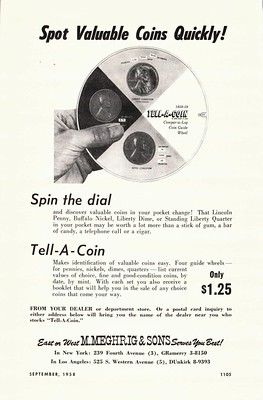 Regarding your request for
more information about the Tell-A-Coin pricing tool in last week's issue, you must have known that I couldn't let such a challenge go unanswered.
Regarding your request for
more information about the Tell-A-Coin pricing tool in last week's issue, you must have known that I couldn't let such a challenge go unanswered.
I have both of the Tell-A-Coin wheels. These are double sided, with one having Lincoln Cents and Buffalo Nickels and the other having Mercury Dimes and Standing Liberty Quarters. Images of both wheels are attached, along with a 1958 ad from The Numismatist for this product.
As for the Disc-A-Log Company, I was not able to find more about that. It doesn't seem to have advertised directly, at least not in numismatic publications.

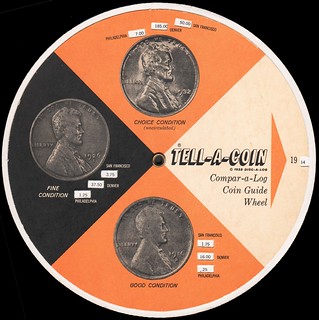
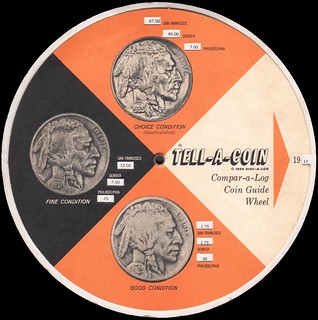
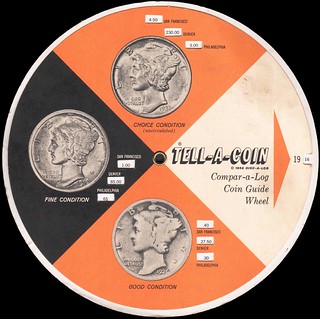
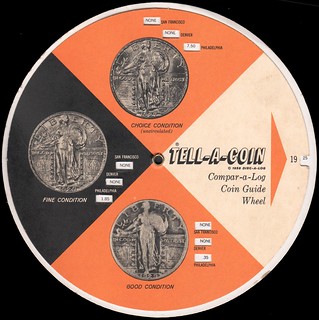
To read the earlier E-Sylum article, see:
NEWMAN PORTAL ADDS TELL-A-COIN GUIDE WHEEL (https://www.coinbooks.org/v22/esylum_v22n44a06.html)
NOTES FROM E-SYLUM READERS: NOVEMBER 10, 2019
A Visit to the Philadelphia Mint
Rich Ponder recently visited the Philadelphia Mint and followed the advice of a coin club group that had gone beforehand. -Editor
Rich Ponder writes:
"Happy to say that I was able to visit the Philadelphia Mint Monday.
"Thanks to Drage's advice, I did bring binoculars and used them. The place appeared no more active than when the group was there, but at least I could closely examine the equipment and the few processes in action.
• 1-cent blanks being stamped out
• Repair or servicing of the conveyor belt that moves the blanks to the later processes
• Servicing of minting machines
• Polishing of 5-ounce silver coins (this in the medals section).
"I got a bargain in the mint store-two squished pennies for the price of one, as a previous customer had not completed turning the crank, and left his or her penny (which was a different design than mine) in the machine. There is something exhilarating about defacing U.S. coins right in front of the Mint security personnel.
"After that we went to the nearby Federal Reserve, where they have an exhibit called "Money in Motion" that includes small but interesting displays of early coins and a cross section of banknotes from colonial to recent. Not a big exhibit but definitely worth a stop. Also got my free souvenir bag of shredded U.S. currency."
Binoculars are a great idea! I've been on that tour where you're walking along a balcony peering down on the production floor. It's hard to see any detail from that distance. -Editor
Translating the Headless Soldier Medal
Regarding the Headless Soldier Medal, Joe Barnosky of Camden, Michigan writes:
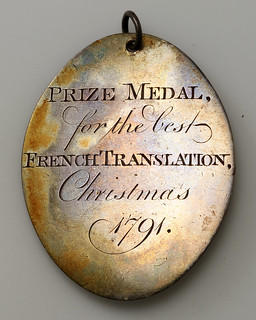 Though I can't offer anything specific
I can easily see the medal's inscription as likely derived from some sickly hilarious but very serious admonition to translators to take their craft very seriously. This
possible "lo and behold" of actually following a translators instructions harkens back to a variously attributed Italian phrase: traduttore, traditore. Loosely,
translators are traitors, which I take as something like the "let the buyer beware" of its genre.
Though I can't offer anything specific
I can easily see the medal's inscription as likely derived from some sickly hilarious but very serious admonition to translators to take their craft very seriously. This
possible "lo and behold" of actually following a translators instructions harkens back to a variously attributed Italian phrase: traduttore, traditore. Loosely,
translators are traitors, which I take as something like the "let the buyer beware" of its genre.
An experienced translator has likely himself seen his own writing as though through the eyes of General Halftrack, in a "Now what?" episode of Beetle Bailey.
If, as is often true even today, the translation is for the benefit of a criminal court, the question "Is that really what happened?" could have sparked many a purchased round at the tavern after work.
The languages are abundant sources of hilarity, sometimes whether the occasion is sobering or not. It is an extremely humbling experience as well. I've told it as like unto being a grown man at a third graders desk and every child in the room knows who the dunce is again.
I could easily see the point being not at all about who is parodied, but of translation not the best, which is well known. A contemporary classic of the same kind of humor as asking "Who ordered the TV antenna" at a Chinese restaurant.
Jeff Rock writes:
If it is an award medal it is likely British in manufacture - there likely wasn't that much French being taught in schools in the early United States (though the closer to French Canada one got that would change). If it is British then it is something at least associated with the upper classes - a hand engraved medal in silver would not be something awarded to just anyone and, of course, being that fluent in French suggests a good education which, at this time, was still the preserve of the upper class.
There is one great source of information that may turn something up. It's a long shot, with emphasis on the long - as it likely requires 1500 pages of reading! But I would suggest that if the owner has the time and inclination that he take a look through The Gentleman's Magazine, published in London, for the years 1790-1791 (I think all the early volumes have been scanned and are available for free online). But if we assume it was school or club-related there may be some notice of it in this magazine - and there may also be an account of something "in the news" at the time that could explain the significance of the obverse design.
While searching a PDF might turn up something, I suspect that the older fonts and sometimes archaic spelling would make OCR unlikely and it would just have to be done by reading each page, which would definitely take some time - but whoever does that may well become the leading expert on British affairs for those years!
Thanks - a good idea. -Editor
To read the earlier E-Sylum article, see:
THOUGHTS ON THE HEADLESS SOLDIER MEDAL (https://www.coinbooks.org/v22/esylum_v22n44a09.html)
The Future of Coin Conventions
Jerry Norton writes:
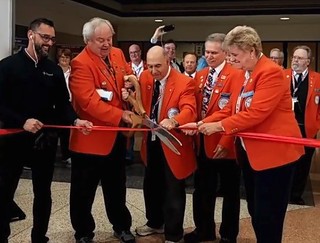 I read (and enjoyed) the entire article written by Jeff
Garrett and am very concerned about local coin shows. I too have found that the internet has had a profound effect on the coin collecting hobby.
I read (and enjoyed) the entire article written by Jeff
Garrett and am very concerned about local coin shows. I too have found that the internet has had a profound effect on the coin collecting hobby.
Thanks for all you do to make the numismatic world so interesting.
You're welcome. The E-Sylum is fun to put together each week. Always something new and interesting. -Editor
To read the earlier E-Sylum article, see:
THE FUTURE OF COIN CONVENTIONS (https://www.coinbooks.org/v22/esylum_v22n44a19.html)
Queen Victoria and the Victoria Cross
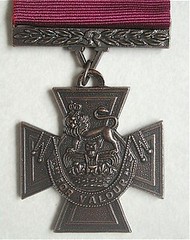 Jim Duncan of New Zealand
writes:
Jim Duncan of New Zealand
writes:
Dick Johnson said Queen Victoria's head was on the Victoria Cross - the closest she got was the V which suspends the medal from its ribbon. She DID create the medal which bears her name, and she did award the first medals, but her head is not there.
Correct - sorry I missed that. See the article elsewhere in this issue about the Canadian War Museum's Victoria Crosses. -Editor
To read the earlier E-Sylum article, see:
VOCABULARY TERM: GALLANTRY MEDAL (https://www.coinbooks.org/v22/esylum_v22n44a12.html)
Correction: Byzantine Era Not BC
Regarding a sentence in last week's article on a find of Byzantine coins in Bulgaria, Kavan Ratnatunga writes:
"A Byzantine gold treasure from the 5th century Byzantine Era,..." should be AD or preferably CE (Common Era)
Good catch. I missed that. Thanks - Editor
To read the earlier E-Sylum article, see:
BYZANTINE GOLD COINS FOUND IN BULGARIA (https://www.coinbooks.org/v22/esylum_v22n44a23.html)
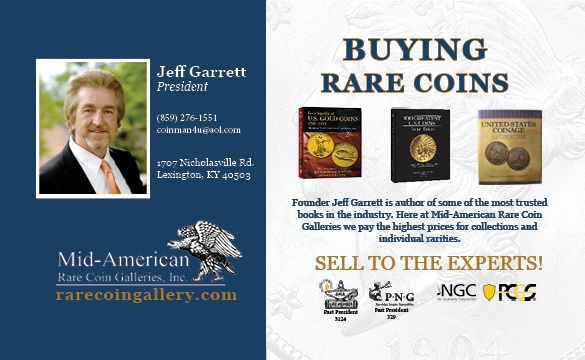
TOOLS FOR THE HUB COIN HOLDERS OFFERED
David Lange submitted these notes on an interesting trove of material related to the Hub Coin Holders. Thanks. -Editor
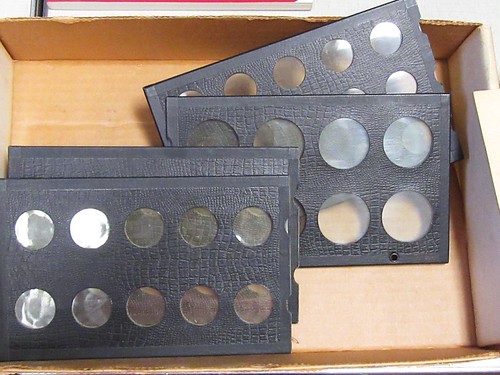
I recently had a phone conversation with Bill Spencer of American Coin in Racine, Wisconsin. Sometime ago he had bought out another old coin shop, and it included a set of tooling that was used to produce the Hub Coin Holders popular during the 1950s. These are similar in form to the Raymond National Coin Album pages of landscape format and frequently are labeled as such by sellers unaware of their true identity. Hub pages are black and holed on their long sides, and they were sold with matching ring binders. In fact, they look more like the Bigelow Holders of the 1940s-50s and are more or less interchangeable with them.
The Hub brand was manufactured and sold by Hubert L. Polzer, and it may be that the name Hub was pronounced as Hyoob. Perhaps, there may be some old timers who actually knew him and can confirm the pronunciation.
Holzer was a prominent coin dealer in Milwaukee. A quick search of The Numismatist archive revealed that he was librarian of the Milwaukee Numismatic Society during the 1950s and had also been president of the Central States Numismatic Society at some point. His ads in the Whitman Numismatic Journal during the 1960s proclaimed that he'd been in business since 1919 and was Whitman Publishing Company's earliest jobber in its coin supply business.
Mr. Spencer inquired whether I'd be interested in purchasing the few remaining Hub coin holders he had in stock, along with the steel punches and collars used to pierce the coin openings in each! The lot also includes a table for determining which punches and collars were used for each coin or token size. While I'm probably the most logical person to preserve this archival material, it's a bit too much steel for me. If someone else is interested in buying the whole lot, I'd love to acquire just one or two pieces from it.
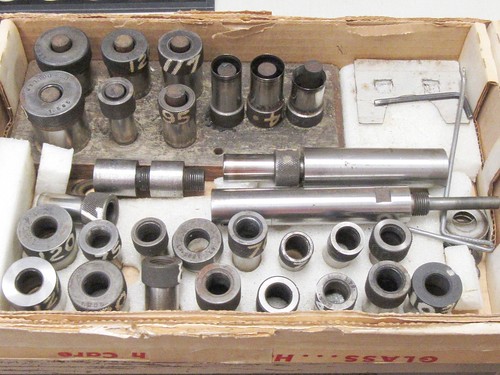
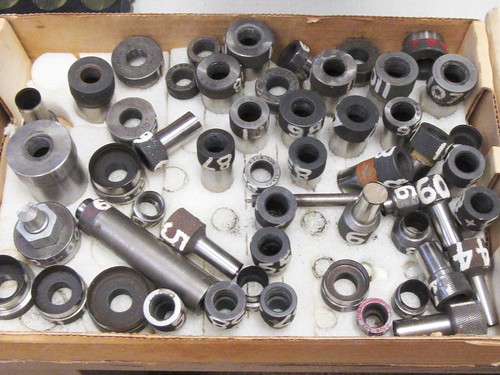
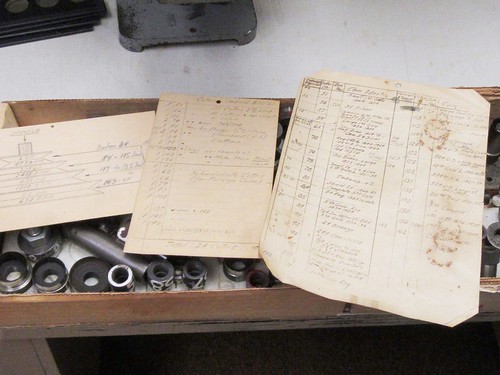
Bill can be reached at:
Bill Spencer
American Coin
262-637-7766
Mon, Wed, Fri 10-5 CST
acsbill@att.net
-Editor
VIC MASON'S THOUGHTS ON U.S. MINT FORUM
Vic Mason submitted this thoughtful essay inspired by last week's report from the fourth U.S. Mint Numismatic Forum. Thanks! -Editor
Many thanks for informing your readers so thoroughly and quickly about the results of the Fourth Numismatic Forum of the United States Mint held late last month in Philadelphia. Patrick Heller's fine summary of the proceedings makes clear that many topics important to the numismatic industry, to dealers and to collectors were covered in the two-day gathering.
Mr. Ryder's Plans for Next Year. It's a pleasure to read that Mint Director David Ryder has plans for production of more limited-circulation business strikes in the future, akin to this year's successful program for the five 2019 Washington quarters produced in carefully limited quantities (two million of each national-park design) at the West Point Mint. I expected Mr. Ryder to announce that decision and to continue working with his staff to improve randomness of distribution of the scarce new business- strike coins.
At the August 2018 ANA convention in Philadelphia, Mr. Ryder expressed a keen interest in changing the way the Mint did business, in order to appeal to young people to carry on this country's wonderful numismatic traditions. As we all know from personal experience, kids need to be “caught” early, especially during their elementary- and middle-school years, to hope to ingrain in them a love of coin collecting. As Mr. Heller notes, that becomes much more difficult when the hunt for scarce and valuable coins in our pocket change – if not impossible these days – has become much more challenging than it was decades ago.
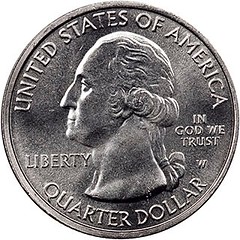 For some months now, I have been pondering how the Mint's distribution program for the scarce new business strikes could be better targeted
to ensure that school children did, in fact, have a much better chance of finding these scarce new coins in their pockets. This year, the Mint did its best to randomize national
distribution of the “W” quarters through the Federal Reserve system, as you yourself suggested it do last fall, both by region and within sub-regions. But we know from the
numerous letters of complaint to Coin World this year from frustrated adult coin collectors that discovery of those quarters did not take place as rapidly and as far afield
as the Mint no doubt hoped would occur.
For some months now, I have been pondering how the Mint's distribution program for the scarce new business strikes could be better targeted
to ensure that school children did, in fact, have a much better chance of finding these scarce new coins in their pockets. This year, the Mint did its best to randomize national
distribution of the “W” quarters through the Federal Reserve system, as you yourself suggested it do last fall, both by region and within sub-regions. But we know from the
numerous letters of complaint to Coin World this year from frustrated adult coin collectors that discovery of those quarters did not take place as rapidly and as far afield
as the Mint no doubt hoped would occur.
Direct Collaboration with Schools. So I searched online to find out some basic national statistics about American schools. I found that, between 2015 and 2016, there were roughly 89,000 elementary schools. And in 2001, there were 26,400 public secondary schools and 10,700 private secondary schools, or just over 37,000 high schools.
The question I asked myself – as a former classroom teacher and education-program administrator in my long first career – was how best to ensure that, for example, more of this year's 10 million “W” quarters might have ended up in the pockets of excited and appreciative kids. I also thought about what the role of teachers and parent-teacher associations (PTAs) might be in working directly with the United States Department of the Treasury, with the Mint, with their local political representatives (at all levels), and with the banks near their schools, in making “Santa Claus-style” executive decisions. I believe coin-collecting parents among the kids would be happy to help get involved in making sure that the implementation of the local distribution processes in most school districts would be carried out as effectively and transparently as possible.
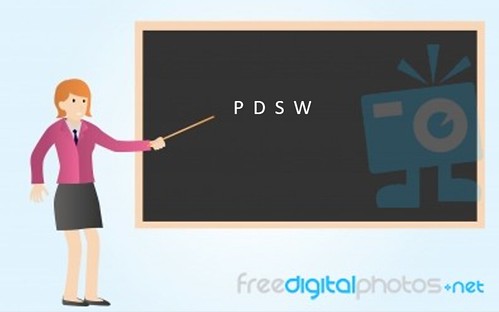
Determination of the Market Values of the “W” Quarters. The good thing about the experience this year with the “W” quarters is that the Mint, the industry and the entire field of coin collecting have gotten a very good idea already of how much the new “W” quarters are “worth” on the market and about how affordable they have become.
I just did a survey of several pages of eBay ads for raw and certified “W” quarters – for all five designs – and I'm pleased to say that there are quite a few pieces of the first four releases, which have been certified by Professional Coin Grading Service (PCGS) and Numismatic Guaranty Corporation (NGC), that are being offered for less than $10 each (combining offered price and shipping fees). That includes even certified coins graded as high as MS67.
Of course, a lot of coins, both raw and certified, are still priced much more expensively, but those prices have to come under considerable pressure, since there will be no market for them. So the letters of complaint to Coin World should soon stop. I saw no certified Frank Church Wilderness “W” quarters offered for sale yet, but their prices are likely soon to compare with those for the other four issues, if the process of mixing and distribution is the same as for the first four “W” quarters issued this year. The few uncertified examples offered are all advertised as being among those found before the official release date and were so publicized by Coin World in recent weeks.
Since so many of the “W” quarters are being pulled out of circulation so soon in mint state condition, even very-high-grade 2019 quarters are now readily affordable. And given the unavoidable contact marks incurred during mixing, bagging and distribution, it will be virtually impossible for anyone except insiders to get their hands on MS-70 examples.
However, there is always the possibility that the Mint may decide, unexpectedly, to make the new Frank Church Wilderness “W” quarters much more difficult to find in circulation than has been the case with the first four 2019 “W” designs. It could do that by mixing the Frank Church “W” coins not only among the Frank Church P and D quarters – the practice followed with each of the first four 2019 “W” quarter designs – but, in a very laborious and, no doubt, time-consuming extra step, by mixing them among the entire population of circulated 2019 and pre-2019 quarters. That would make the search for the Idaho quarters much tougher – and thus make the mint-state Idaho “W” quarters much more valuable.
Mr. Ryder has not tipped his hand as to what he plans to do with these last 2019 quarters or with the new coins next year. Mr. Heller says only that Mr. Ryder “may revise the process in how [the 2020 coins] are dispersed.”
New Kennedy Quarters and Innovation Dollars. Mr. Heller suggested the Mint follow a similar distribution plan for the new Kennedy half dollars and one-dollar Innovation coins. He proposes a demand-side approach to increasing interest in these two series. How about a supply-side tack instead, similar to the year-2000 program organized with the Kellogg Company to put Sacagawea dollars randomly into cereal boxes.
But the initiative could be conducted on a much broader scale in cooperation with many more manufacturers than the 5000 Sacagawea dollars distributed by Kellogg in 2000. Why not have a public- private partnership (PPP) to implement such a program with as many companies collaborating as possible? The Mint could follow both approaches simultaneously, thereby seeing experimentally which works better and/or is more popular with the public. Or both approaches (including both proofs and circulating issues) could be pursued.
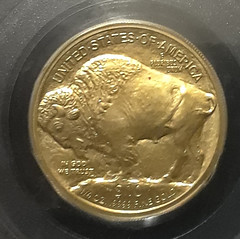
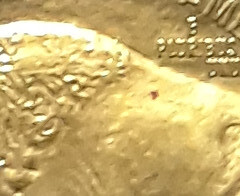
Copper spot on a gold Buffalo
Copper Spots on Gold Coins. It was good to learn about the chemical causes of the copper spots on gold coins. A decade ago, I received an MS-68 grade from PCGS on a 2008-W burnished quarter-ounce Gold Buffalo, while the tenth-ounce, half-ounce and one-ounce coins in that valuable set all came back with higher grades, two of them as MS-70. The quarter-ounce coin had an unsightly copper spot on it. Perhaps one of E-Sylum's experts could explain whether that single blemish – other things being equal – would be enough to knock down the grade and the market value of the coin so significantly. I also have such a glaring spot on a 1909-S Indian Head cent graded MS 63, red-brown, by PCGS.
Impurities Refined Out of Gold and Platinum Coins. The article says that U.S. Mint Chief Assayer Jeannette Grogan mentioned that there are up to 13 potential impurities in gold that the Mint tests for, and 24 in platinum. Perhaps the Mint secretly could deliberately retain microscopic quantities of a certain chemical, or chemicals, in the alloy mix, for an entire production run of an issue, for either a bullion or a commemorative coin. Then no matter how perfectly – with state-of-the-art technology – a counterfeit might be made (of, for example, an otherwise very rare or scarce issue), the Mint would always be able to prove definitively whether or not a coin was an official government product.
Embargoed Early Distribution of New Coins. I think it's a bad idea for the Mint to seriously consider shipping any coins early to purchasers. We saw a few years ago how there are always insiders ready to game the system for selfish profit. I'm thinking back to the attempts by some insiders, in late 2014, to obtain early releases of a few of the 2015 U.S. Marshals Service Commemorative coins celebrating the 225th anniversary of that agency. When those efforts were revealed, the insiders were forced to return the coins to the Mint.
Dates and Mint Marks on the Edges of Coins. I hope that no dates and mint marks on US coins are ever again approved for placement on their edges. Even if I had the eyesight of 70 years ago, I would still say that anyone promoting such an absurd placement of important data on coin edges is thinking like a bureaucrat, not a collector. I'm sure Teddy Roosevelt 110 years ago would have snorted derisively at such a design move – as if the main two faces of a coin didn't have enough “space” for those five little symbols: the date and the mint mark.
To read the earlier E-Sylum article, see:
2019 U.S. MINT NUMISMATIC FORUM HELD (https://www.coinbooks.org/v22/esylum_v22n44a18.html)
U.S. MINT SEEKS TWO MEDALLIC ARTISTS
The Design and Engraving Division, US Mint Philadelphia has two job openings for medallic artists closing on November 18, 2019. Know anyone who'd make a great coin or medal designer? Pass these along! Thanks to Bill Nyberg for the heads' up. Here's an excerpt from the job description. -Editor
Summary
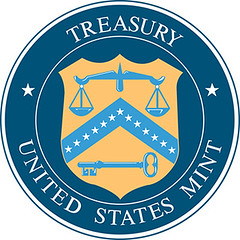 This position is located in the United States
Mint, Philadelphia, Design and Engraving Division. The major mission and function includes the manufacturing of domestic circulating and numismatic coins, medals and other
products.
This position is located in the United States
Mint, Philadelphia, Design and Engraving Division. The major mission and function includes the manufacturing of domestic circulating and numismatic coins, medals and other
products.
Responsibilities
The following are the duties of this position at the GS-13 full performance level. If you are selected at a lower grade level, you will have the opportunity to learn to perform
all these duties, and will receive training to help you grow in this position.
Create designs in 3-D graphics formats using electronic sculpting software; or design and develop 3-D models of varied materials that can be scanned with non-contact scanning /digitization systems and revised or modified digitally.
Design, implement and execute clay, wax or plaster models to required specification scales in low relief of accepted designs. Represent the United States Mint at selected public functions and ceremonies.
Analyze, evaluate, coordinate and participate in test/trial strike reviews and events; and recommend appropriate technical modifications and changes to optimize and promote efficient and effective coin, medal and other devices production processes and efforts.
Travel Required
Occasional travel - infrequent travel - ceremonies, etc.
Qualifications
Experience creating designs and models for use in manufacturing hubs and/or dies; designing, sculpting, and creating finished renderings for coinage and medals; using digital
design, sculpting software and other bas relief sculpting tools; sculpting with plastilene, clay, wax or other material & creating plaster models. Experience presenting and
communicating orally or in writing to varied audiences.
Examples of such experience could include:
- Creating designs for United States Mint coinage, Congressional gold medals and other devices. AND
- Creating designs in 3-D graphics formats using electronic sculpting software. AND
- Representing an organization at selected public functions and ceremonies. AND
- Interacting with oversight committees and/or boards advocating for or taking a certain position on sculpture designs and techniques. AND
- Participating in and becoming a finalist for design competitions.
For more information, or to apply, see:
Medallic Artist DEPARTMENT OF THE TREASURY U.S. Mint (https://www.usajobs.gov/GetJob/ViewDetails/550721300)

1921 SILVER DOLLAR ACT GAINS SPONSORS
In other Mint news, there are some new cosponsors for H.R.3757, the 1921 Silver Dollar Commemorative Coin Act we'd discussed before. U.S. readers - please contact your Congressional representative and ask for their support. -Editor
1921 Silver Dollar Commemorative Coin Act
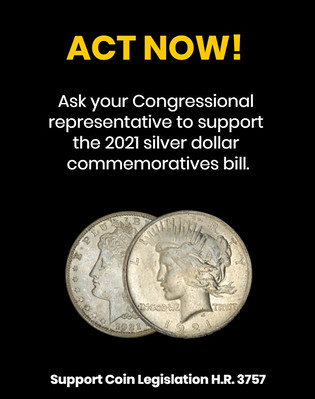 This bill directs the Department of the
Treasury to mint and issue up to 500,000 $1 silver coins in commemoration of the centennial of the re-minting of the Morgan silver dollar that was designed by George T. Morgan and
the minting of the Peace silver dollar that commemorated the declaration of peace between the United States and the Imperial German government.
This bill directs the Department of the
Treasury to mint and issue up to 500,000 $1 silver coins in commemoration of the centennial of the re-minting of the Morgan silver dollar that was designed by George T. Morgan and
the minting of the Peace silver dollar that commemorated the declaration of peace between the United States and the Imperial German government.
Treasury may issue such coins only for a one-year period, beginning on January 1, 2021.
All surcharges received from sales of such coins shall be paid as follows:
• 40% to the American Numismatic Association for numismatic educational activities;
• 40% to the National World War I Museum and Memorial in Kansas City, Missouri, to educate and commemorate activities related to World War I and its enduring impact; and
• 20% to the Nevada State Museum in Carson City, Nevada, to support the preservation of the historic features of the museum related to the U.S. mint, the design of interpretive programs that connect visitors to the significance of minting in the United States, the Comstock Lode, and the American West, and to support the activities of the Nevada Division of Museums and History.
What's not to like? Here are the Representatives who've signed on as Cosponsors to date. -Editor
11/08/2019 Rep. Eshoo, Anna G. [D-CA-18]
11/08/2019 Rep. Crawford, Eric A. "Rick" [R-AR-1]
11/05/2019 Rep. McKinley, David B. [R-WV-1]
11/05/2019 Rep. Guthrie, Brett [R-KY-2]
11/05/2019 Rep. Wagner, Ann [R-MO-2]
10/21/2019 Rep. Thompson, Glenn [R-PA-15]
09/24/2019 Rep. Kelly, Mike [R-PA-16]
09/24/2019 Rep. Clay, Wm. Lacy [D-MO-1]
09/20/2019 Rep. Hartzler, Vicky [R-MO-4]
09/20/2019 Rep. Hill, J. French [R-AR-2]
09/19/2019 Rep. Smith, Jason [R-MO-8]
09/19/2019 Rep. Stivers, Steve [R-OH-15]
09/19/2019 Rep. Wittman, Robert J. [R-VA-1]
09/19/2019 Rep. Long, Billy [R-MO-7]
09/19/2019 Rep. Graves, Sam [R-MO-6]
09/17/2019 Rep. Reschenthaler, Guy [R-PA-14]
09/16/2019 Rep. LaMalfa, Doug [R-CA-1]
09/16/2019 Rep. Riggleman, Denver [R-VA-5]
09/16/2019 Rep. Scalise, Steve [R-LA-1]
09/16/2019 Rep. Amodei, Mark E. [R-NV-2]
07/15/2019 Rep. Barr, Andy [R-KY-6]*
The latest cosponsor is a Democrat, but most of the cosponsors are Republicans. Where are the Dems? It's especially important to get more bipartisan support. So everyone, please take a few moments to call your Representative's office. -Editor
To find Your Representative by Zip Code:
https://ziplook.house.gov/htbin/findrep_house?ZIP=
For more tools on the ANA web site, see:
https://numismatic.lpages.co/coin-legislation/
For more information, see:
Summary (https://www.congress.gov/bill/116th-congress/house-bill/3757)
Cosponsors
(https://www.congress.gov/bill/116th-congress/house-bill/3757/cosponsors?pageSort=lastToFirst&loclr=cga-bill)
To read the earlier E-Sylum article, see:
SUPPORT THE 2021 SILVER DOLLAR COMMEMORATIVES! (https://www.coinbooks.org/v22/esylum_v22n30a14.html)
VOCABULARY TERMS: GOLDPLATE, GOLDPLATING, PART 1
Dick Johnson submitted this entry from his Encyclopedia of Coin and Medal Terminology. Thanks. It's an important but lengthy one - I'm splitting it into two parts; here's the first. -Editor
Goldplate, Goldplating. Application of gold to any surface by electrodeposition. Because gold is an element that conducts electricity it can easily be electroplated. Developed at the same time as silverplating (which was invented in Germany in 1837 and patented in England in 1840) goldplating proved useful for coating small manufactured objects. Gold can be deposited in a very thin amount, even with a few microns the object takes on the color of gold.
All but a few metallic surfaces can be goldplated. An object can be manufactured in any metal (most often an alloy) then goldplated to give it a gold color. This is done, obviously, to reduce cost, and yet to provide an object that has most of the qualities – except weight and fineness! – of solid gold.
While any metal can be goldplated, the most practical is gilding metal, a copper-zinc bronze alloy which has excellent properties of being manufactured. There are several metals, notwithstanding, which cannot be goldplated directly, iron is one of these. However even these can be plated with an intermediate metal, like nickel, then this can be goldplated.
Goldplated objects are also called gilt or gilded (see gilding). Goldplated silver is called vermeil, it has the color of gold but the sheen of silver. While similar in color, rolled gold is a clad metal where thin strips of gold are clad to a thicker base metal before blanks are cut and the piece is struck; it is not an electrochemical process. Gold leaf is an entirely different process from goldplating – it is a physical application of thin leaves of gold, not an electrochemical one.
Color of gold in goldplating. Yellow gold is free of impurities, but tiny amounts of other elements in natural gold will color (change the hue) slightly. White gold has silver or platinum impurities, pink or red gold has copper impurities, green gold has iron impurities, and the very rare black gold has bismuth impurities.
Each of these, except black gold, can be obtained by goldplating, either in the tank at the time of goldplating, or afterwards. Yellow gold is obtained by "pure" goldplating without any other metal ions in the plating solution. While white gold could be plated with silver or platinum, the same results can be obtained with tin (as sodium stannate) or nickel in the plating solution. Copper is introduced into the solution for a pink or red gold. For a green gold effect, the object is plated with silver (potassium silver cyanide) and lead acetate. See Gold Color Chart, gold.
History of goldplating. Prior to 1840 objects were covered with gold by laying on gold leaf, or by firegilding, a process employing mercury. The mercury fumes driven off were harmful to workers so the process was prohibited in advanced countries, replaced for the most part by goldplating.
But firegilding continued even in America up to 1880s. Early electrolysis was run off primitive batteries; with the introduction of commercial electricity in the 1880s it became economical to do extensive gold and silverplating. This finally eliminated firegilding entirely.
The earliest goldplating was done in quite small containers. The field has progressed, as one writer indicated, from the pint jar to the 50-gallon tank. However with the high cost of gold anodes, goldplating is done in small batches in small tanks. (Further details, identifying the people credited for developing electroplating, is given in the entry under electrolysis.)
Technique of goldplating. An anode of pure gold is required; the work – the object to be goldplated – becomes the cathode. Both are placed in an electrolytic solution, a cyanide bath containing some gold ions already in solution. Both are wired to complete an electrical circuit and the current supplied through a rectifier. Ions of gold are electrically charged and leach from the positive anode.
The ions in the electrolyte solution are attracted to the cathode that is negatively charged and instantly deposited on the cathode (object). Time is a critical factor. The longer the object remains in the solution and the current is on – the greater the thickness of gold builds up on the object. See electroplate, electroplating.
Goldplating thickness. Most goldplating is very thin with a brief time in the tank. A thin plating – called flash plate, or particularly for gold, a gold wash – is suitable only to give the object a gold color. This can be as thin as .000001 of an inch with a cost averaging 60 cents per square foot when gold was $150 an ounce (or 250th the cost of an ounce of gold). Such a plated piece cannot be finished in any manner other than lacquering. At this stage the gold can be rubbed off with repeated rubbing of human skin (collecting in the skin's pores or finger ridges).
Longer time – and thicker plating – give a deeper coating of gold. This will be reflected in both color and texture of the piece, entirely resembling gold on all surface exposed in the electrolytic tank. heavy goldplate is a result of this thicker coating, it has been identified on some items made before 1900 as XX or even XXX (triple X or triple plate) gold. This thicker plating must be reflected in the higher cost, fifty to sixty dollars per square foot (one-third the cost of an ounce of gold) because of the greater amount of gold being deposited.
Additional plating or hardness can be made by removing the item from the goldplating tank and placing it in the silver tank for only a short time. Adding one part silver say, to 50 parts gold, increases the hardness but still retains the gold color. See hard goldplate.
Advantages of goldplating. Several reasons exist for goldplating medals: (1) gold medals are a class of award medals, (2) gilding is a popular form of finish, (3) gold is a desirable color for medals as a gift, jewelry or award item, (4) gold does not discolor skin when worn on the body, (5) gold covers up surface discolorations and shallow imperfections of manufacture, (6) it is a time-honored metallic color, and, perhaps most important, (7) gold finish does not tarnish.
Medals can be easily goldplated because of their size and shape, thus goldplating is widely done in the medallic field. Thousands of medals can be goldplated from a single ounce of gold, the unit cost can be comparatively low even in times when the cost of gold is high. Medals, obviously, are goldplated rather than struck in solid gold to reduce cost.
The second part of this entry will appear in next week's issue. -Editor
Looking for the meaning of a numismatic word, or the description of a term? Try the Newman Numismatic Portal's Numismatic Dictionary at: https://nnp.wustl.edu/library/dictionary
Or if you would like a printed copy of the complete Encyclopedia, it is available. There are 1,854 terms, on 678 pages, in The Encyclopedia of Coin and Medal Technology. Even running two a week would require more than 19 years to publish them all. If you would like an advance draft of this vital reference work it may be obtained from the author for your check of $50 sent postpaid. Dick Johnson, 139 Thompson Drive, Torrington, CT 06790.
CHARLES T. GRAY (1807-1875)
Charles T. Gray (1807-1875), was born in Newark, Essex County, New Jersey.
He is of some interest to scrip collectors since is a signor on Post Office Department Drafts, and Silver Mining Stock Certificates, and other local Newark scrip with his serving various capacities as City Treasurer, Secretary of the Road Board, Treasurer of the Newark Library Association. He was affiliated with the family of William Raymond Weeks of the ANS.
He married Hannah Ann (1810-). They had three children : Charles Gray, Jr. (1845-1849), Charlianna Fanny Gray (1848-), Jeremiah H. Gray (1851-).
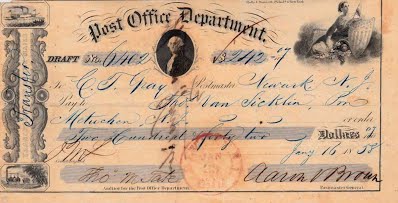
IN 1847, he served on the School Board for the City of Newark, New Jersey. He was appointed Postmaster, Newark, New Jersey, on April 6, 1853. He worked there at the Post Office, Custom House Building, Academy and Broad Streets, Newark, New Jersey.
In 1859, he was the Treasurer of the Newark Library Association.
From 1862-1868, he was the City Treasurer of Newark, New Jersey.
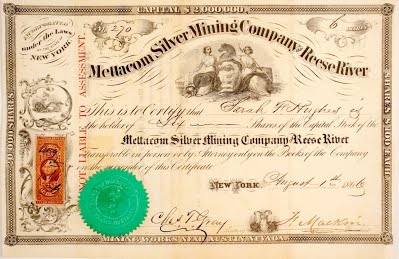
Mettacom Silver Mining Company Reese River. Signatories : Charles T. Gray, Secretary, and H Mackin, President.
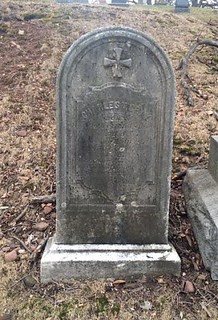 In 1870, he was the Secretary of the Road
Board, and lived with John R. Weeks a successful attorney, and Mary F. A. Weeks in their Newark mansion. They were the parents of William Raymond Weeks of ANS fame.
In 1870, he was the Secretary of the Road
Board, and lived with John R. Weeks a successful attorney, and Mary F. A. Weeks in their Newark mansion. They were the parents of William Raymond Weeks of ANS fame.
He died on the March 2, 1875. He is buried in Rosedale Cemetery, Orange, Essex County, New Jersey.
To read the complete article, see:
GRAY, CHARLES T. (https://sites.google.com/a/numismaticmall.com
/www/numismaticmall-com/gray-charles-t)
The entire inventory of the Lupia Numismatic Library is for sale. Individual items will be available before the remaining archives are broken up into parcels sold at philatelic auctions in the U. S. and Hong Kong. Check NumismaticMall.com frequently as dozens of new items with estimates will be posted daily until everything is sold.
All inquiries will be given prompt and courteous attention. Write to: john@numismaticmall.com .
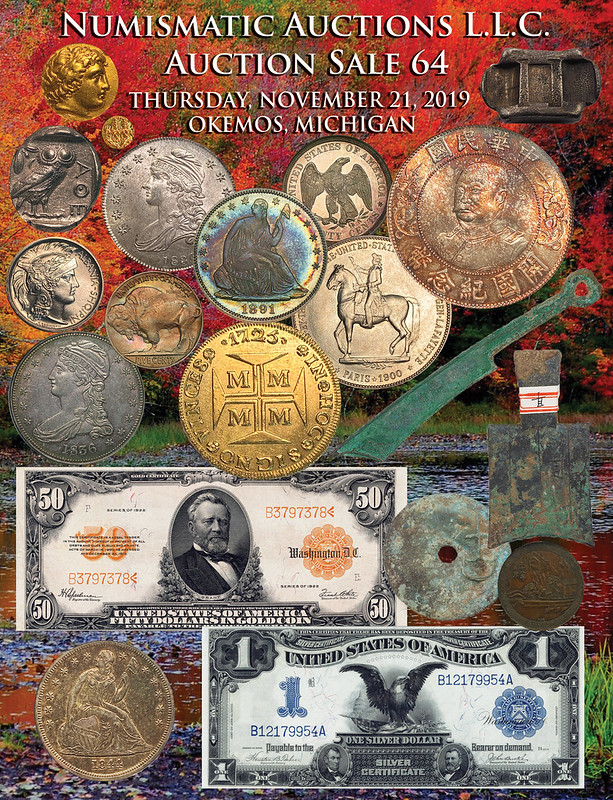
THE COLLECTION OF WILLIAM SPOHN BAKER
Numismatic bibliophiles know about William Spohn Baker's classic book on the medals relating to George Washington. His reference collection, long owned by the Historical Society of Pennsylvania, is being auctioned this month by Stack's Bowers Galleries. Here's an excerpt from a blog article by cataloguer John Pack. -Editor
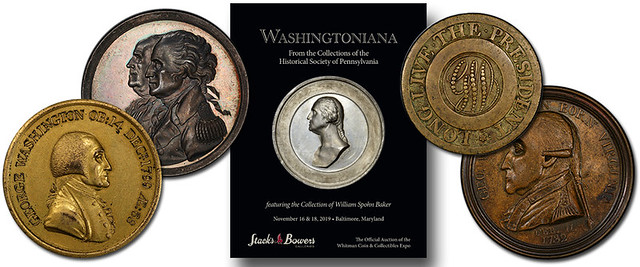
Perhaps the best starting point for a sale like this is a quote from William Spohn Baker, written in November 1884, as it summarizes the inspirations behind this landmark collection in the collector's own words:
"Washington Medals form no inconsiderable portion of that great monument which love and gratitude have so steadily builded [sic], in memory of the services and virtues of the foremost man in American history.
"This form of expression has, however, lost much of its historic significance and fitness in the absence of a systematic arrangement, by which all its features could be intelligently viewed and comprehended. Partial lists of the medals have been made, but without any attempt at classification, which while useful within their limits, have at the same time rather bewildered than aided the student or collector."
Baker's name is legendary in American numismatics. For more than a century, it has been associated with the series of Washington medals, as it is he who first systematically and exhaustively organized this body of material in the 19th century in his 1885 work, Medallic Portraits of Washington. “Baker” is virtually synonymous with Washingtoniana. There are very few names from that period still in use in similar context today, though Sylvester Crosby with his Early Coins of America, Edward Maris' Coins of New Jersey, and William T.R. Marvin's Medals of the Masonic Fraternity come to mind as notable exceptions. It is perhaps the only such case, however, where the original reference collection has remained intact.
The opportunity to handle a collection like this is, in a word, extraordinary. As a firm, we have handled several collections of the 19th century, the cabinets of the Garrett family and Walter Childs coming immediately to mind. However, in the Baker Collection we have something very different from the norm. Where most collections of the period are somewhat general in scope, or focused on circulating coinage issues, his was a deeply specialized cabinet focused solely on medals collected by a passionate and pioneering student of the series.
Baker's motivation seems to have been, first and foremost, personal fascination with the historical subject. However, he was also deeply interested in expanding general understanding of the subject and saw the medals as an avenue one could take to accomplish this. The earliest medals were inspired by people who were Washington's contemporaries, and perhaps even knew him directly. Slightly later issues were devised by those who wished to memorialize him or his deeds for the next generation. Later, as Baker observed, the use of Washington's portrait was seen as adding gravitas to any subject at hand. In his introduction, Baker wrote:
"It needs but a glance at the titles of the different groups, to reveal how the name of Washington is associated in the minds of a people, with all their diversified interests, pursuits and enterprises….If benevolence is to be awakened, patriotism aroused, emulation excited, temperance inculcated, industry stimulated, or events to be celebrated, the mind of the designer seems to turn at once to the Pater Patriae, and the medal struck for the purpose or occasion, must of course, bear his head as the prominent object."
Though it may not have been central to his intent, it is worth noting that Baker's categorizations and groupings illustrated the inspirations for the various issues and separated the more important historic issues specific to Washington and his memory from those created for purely commercial purposes.
Baker assembled his collection with primarily his own scholarship as a background. A small selection of the early medals had been well-described by James Ross Snowden, published as Medallic Memorials of Washington in the Mint of the United States, in 1861. For this Snowden worked simply from the medals that formed the Washington Cabinet in 1859, the seed that would become the National Numismatic Collection at the Smithsonian Institution. William Sumner Appleton published a listing of his extensive collection in 1873, including 296 types he owned and a few additional ones he was aware of. Entries in the American Journal of Numismatics likewise helped with data on known issues. However, Baker collected without benefit of systematic, comprehensive and detailed references as we understand them today. Beyond the mentioned references, and auction catalogs that offered specimens for sale, information was scarce. There was nothing to place this extensive and ever-increasing body of medallic work honoring Washington into proper context. In this, Baker saw an opportunity to create a thematic roadmap for future collectors. His goals were to make more accessible the history of the subject, and to expand understanding of the objects he enjoyed studying and collecting. He missed very little, and his accomplishment was remarkable. It is illustrative to consider that when Baker was assembling his collections of medals and engraved portraits, collectors did not have the benefit of easily accessible and vast photographic archives that present-day collectors rely upon. Collectors had to rely upon the written word, their own imaginations, and experiences with like items. Even Baker's own references were without illustration. Collecting in that time was, by necessity, a thoroughly academic and thoughtful pursuit.
Baker's scholarship on the topic was perhaps unparalleled in his day. In The Pennsylvania Magazine of History and Biography, Vol. 22, No. 1 (1898), published by the Historical Society of Pennsylvania, John W. Jordan contributed an article, “In Memoriam. William Spohn Baker.” Therein, Jordan wrote about the recently deceased Baker, as his contemporary:
He practised [sic] his profession for some years, and then turned his attention to literary pursuits and historical research, particularly in all matters relating to Washingtoniana, of which he was recognized the foremost authority in the United States.
His collection of medals, coins, and tokens numbers upwards of eleven hundred pieces. In bequeathing all his treasures to the Historical Society, he knew that they would always be appreciated and receive the care and attention he had bestowed upon them, and that they would be made accessible to the historical student.”
While we as numismatists know him well for his work with the Washington medals, Baker was an ardent student and collector of all scholarly works relating to Washington. His library included around 500 print volumes on his subject, while his collection of engravings and prints of Washington is said to have numbered as many examples as his cabinet of medals. He published numerous works of his own. His reference work on portraits, Engraved Portraits of Washington, was published in 1880, five years in advance of the reference numismatists have used to classify their Washington medals for over a century.
Baker was a lifelong resident of Philadelphia, where he was born in 1824 to parents who had deep roots in the history of the area. One of his maternal great-great grandfathers arrived in Germantown in 1688 and one of his paternal great-grandfathers moved to Philadelphia in 1740, the latter serving in the American Revolution, as did others in his family. Baker was elected a member of the Historical Society of Pennsylvania in 1873 and was devoted to the Society for the remainder of his life. He became a member of its governing Council in 1885, and a vice president of the organization in 1892.
According to Jordan's memorial, he was also affiliated with numerous other respected organizations, often holding offices therein. Among these may be counted the Pennsylvania Society of the Sons of the Revolution, the American Philosophical Society, the American Historical Association, the American Numismatic and Archaeological Society of New York, the New Jersey Historical Society, the Society of the War of 1812, and the Colonial Society of Pennsylvania. He was a director of the School of Design for Women for a few years, and served in the same capacity in the Pennsylvania Academy of Fine Arts, where he later became a vice president. He also held directorships in the Athenaeum of Philadelphia and in the Commercial National Bank.
To read the complete article, see:
Welcome to Washingtoniana From the Collections of the Historical
Society of Pennsylvania Featuring the Collection of William Spohn Baker
(https://www.stacksbowers.com/News/Pages/Blogs.aspx?ArticleID=william-spohn-baker-collection-nov-2019)
NUMISMATIC AUCTIONS LLC SALE 64
Steve Davis of Numismatic Auctions LLC has a new auction closing later this month. Here's the text of his introduction to the catalog, which lists many of the sale's great highlights. Check the catalog carefully - there are many super items here. -Editor
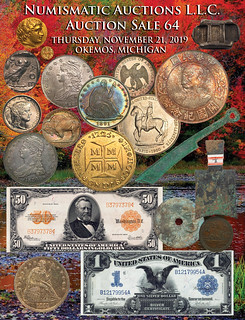 Well another year is behind us and the
trees have changed their colors and shed their leaves. We welcome you to this our Auction Sale 64 with one of the most widely varied arrays of items one could possibly ask for.
You will find within these pages a great mix of United States, Canadian, Ancients, World Gold, World Coins, Paper Money, Tokens & Medals and other material for your bidding
pleasure. Should you be considering selling items in our upcoming Spring 2020 Auction, deadline for consignments is January 31, 2020 and capacity is already nearing the full
mark.
Well another year is behind us and the
trees have changed their colors and shed their leaves. We welcome you to this our Auction Sale 64 with one of the most widely varied arrays of items one could possibly ask for.
You will find within these pages a great mix of United States, Canadian, Ancients, World Gold, World Coins, Paper Money, Tokens & Medals and other material for your bidding
pleasure. Should you be considering selling items in our upcoming Spring 2020 Auction, deadline for consignments is January 31, 2020 and capacity is already nearing the full
mark.
Among the many highlights this sale are a nice run of U.S. Coins, type and series coins, short sets and more from Half Cents to Dollars including a vast number of entry level Large Cents, some nice Indians and Lincolns featuring several 1909-S VDB and 1909-S issues followed by some high grade and colorful type and Proofs, a neat ensemble of nice Proof Shield and Liberty Nickels and a pair of Mint State 3 Leg Buffalos; a fantastic pair of Proof 20 Cent Pieces, collector grade and certified Capped Bust Halves and a rare 1836 Reeded Edge Half Dollar, a group of Seated and Trade Dollars including multiple Proofs, GSA Dollars in quantity, a sizable Collection of Beautiful Large Size and Small Size paper and beyond.
For exonumia enthusiasts, we offer such jewels as a marvelous original 1862 intact grouping of tokens and a pair of auction catalogs from the famed Coin Dealer Henry Cook and a San Francisco Mint Silver Ingot. The Canadian segment provides an interesting and good sized collector run of Large Cents to Silver Dollars and more including a several nice Victorian to George V and VI Type coins highlighted by the 1948 Dollar rarity. The historic Ancient realm encompasses an esoteric group with some better grade Greek, Roman and Byzantine coinage with popular types and a modest Gold presence.
A large and impressive run of Chinese coins in Ancient types is next up, including a rare group of Spade & Knife Money, Early Round Hole Cash up to Republic Silver, topped by an MS65 trophy grade Li Yuan Hung Dollar with spectacular color, the Chinese offering spans many pages featuring items from the Legendary Chicago Confectioner & Candy Barron Charles Gunther's Museum and is rounded out by such things as his prized Ming Bao Chao 1 Kuan note with the original transmittal letters from 1888.
Another exciting journey is into the varied arena of rare minors to Crowns, a nearly complete date run of British Maundy Sets along with other World coinage in singles, sets, date/type runs and small group lots. Within the sale are many national or regional specific lots throughout, all awaiting your curiosity and interest.
As usual we bring an onslaught of large and miscellaneous lots under the auction gavel to round out the sale alongside tokens & medals along with Part One of a lifelong collection of Rare and Better World Paper Money from a gentleman collector who resided in Costa Rica for nearly 50 years. This initial offering features a phenomenal listing of currency from Costa Rica, both Specimens and regular issues – this magnitude of variety and scarcity has not been available in the market in one place in many, many years. A wonderful opportunity for you South American currency specialists! Stay tuned for Sale 65, which is just around the corner with part two from that fine collection of notes!
Our schedule for 2020 is already booking up fast. If you are considering selling, there is no better time than the present – contact us today for a confidential consultation. There are countless buyers actively seeking fresh material from every corner of the Earth. Now is a great time for you to sell, prices are strong. We provide personal service, low commission rates and we will help you sell all of your material, including your lesser value coins, not just cherry-pick your holdings as many buyers or big firms do. Why sell your collection to just one dealer? Thousands of collectors and dealers around the globe will compete to pay the most for your material. We can travel to assist you in the process and have a proven track record with our consignors – we will happily provide references. Remember, our next deadline to submit coins for inclusion in our upcoming Spring Auction Sale 65 is January 31, 2020 - don't miss out - call us today!
My thanks to all of you, both consignors and bidders, for your patience during the lengthy process of writing another epic book highlighting your many long years of acquisitions and all my best for the upcoming summer! Special thanks and gratitude to my wife Lisa for her invaluable help in catalog production over the last several months. We hope you truly enjoy this, our 64th Numismatic Auction listing – we appreciate your years of bids, purchases and consignments. It is always a pleasure to participate in this great hobby with all of you.
To view the catalog, see:
https://img1.wsimg.com/blobby/go/075b3140-6c2f-424b-9430-33ae53c577e5/downloads/Auction%20Sale%2064%20Catalog.pdf?ver=1573067267463
NUMISMATIC NUGGETS: NOVEMBER 10, 2019
Here's a selection of interesting or unusual items I came across in the marketplace this week. Tell us what you think of some of these. -Editor
Fountain Tavern Token
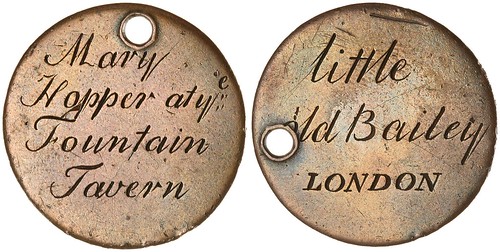
Description: Fountain Tavern token, created on a shaved down halfpenny (6.39g), pierced hole at edge, obverse inscribed in running script, 'Mary/Hopper at ye/Fountain/Tavern', reverse also inscribed in running script, 'little/old Bailey/LONDON'. Very fine.
Notes: The Fountain Tavern was sited on the west side of Little Old Bailey and was demolished in 1793; the site is now under Holborn Viaduct Station. The tavern was nearby to Newgate Prison and most probably operated as a brothel. The above token is possibly an indentured servant's ID disc.
From the Noble Numismatics November 20, 2019 sale. -Editor
To read the complete lot description, see:
Lot 2579: British Historical Medals (https://www.invaluable.com/auction-lot/-1-c-71943C5B2C)
Silver Palmetto Medal
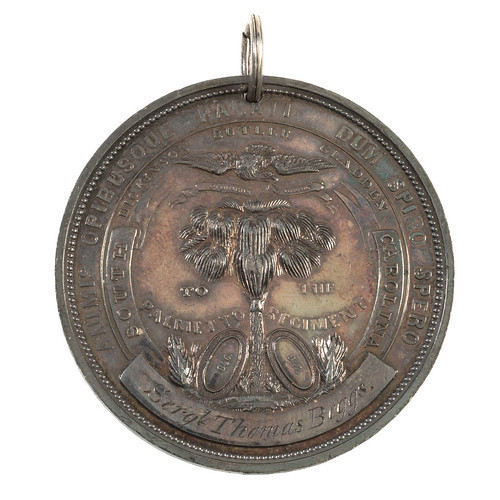
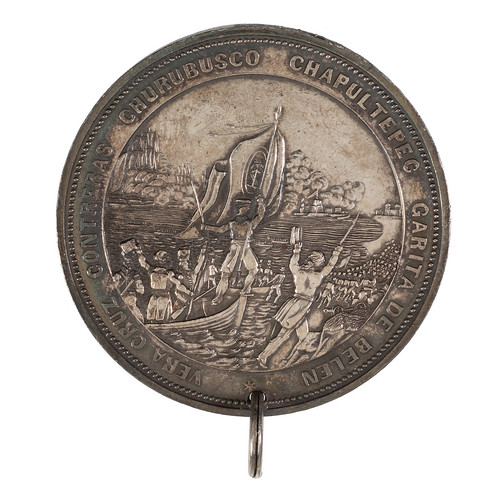
Palmetto medal in silver, 47 mm. dia., 45.2 g, engraved by William J. Keenan and struck by Gregg, Hayden & Co., 1850s. Obverse with depiction of American troops landing at Vera Cruz encircled by border featuring the names of Mexican-American War battles; reverse with central palmetto and eagle motif surrounded by the names of the Palmetto Regiment's commanders, "Dickinson," "Butler," and "Gladden," and variously placed additional text including "TO THE / PALMETTO REGIMENT," "SOUTH / CAROLINA," the name of the medal's recipient, "Sergt. Thomas Beggs," and the years "1846" and "1847," all encircled by border with legend bearing the two state mottos of South Carolina, "ANIMIS OPIBUSQUE PARATI" and "DUM SPIRO SPERO," meaning "prepared in mind and resources," and "while I breathe I hope," respectively.
The Palmetto Medal was authorized by the South Carolina Legislature in 1848 and issued in the 1850s to men who fought in the Palmetto Regiment during the Mexican-American War. The medal was struck in silver for enlisted men and non-commissioned officers, and in gold for officers. Many veterans wore their medals on watch fobs or chains, causing many of the surviving medals to be quite worn or damaged. The fine condition of this example alone makes it an impressive specimen, let alone an important piece of history.
The Palmetto Regiment of Volunteers was an infantry regiment formally organized on June 26, 1846. It contributed ten companies of men to the US forces in the Mexican War. Having numerous volunteers, the regiment was trained by cadets from the South Carolina Military Academy and was recognized as the first regiment to fly American colors over Mexico City. The regiment's landing at Vera Cruz is captured in the obverse design of the medal featured here, showing Colonel Pierce Mason Butler ready to spring from his ship with the Palmetto flag in hand. Both Colonel Butler and Lieutenant Colonel Dickinson (the names of whom appear on the medal's reverse) received fatal wounds at the later Battle of Churubusco in August of 1847.
I was unfamiliar with this South Carolina medal. Offered in Cowan's Auctions November 15, 2019 sale. -Editor
To read the complete lot description, see:
Silver Palmetto Medal
Awarded to Sergeant Thomas Beggs for Service in the Mexican-American War, 1848
(https://www.cowanauctions.com/lot/silver-palmetto-medal-awarded-to-sergeant-thomas-beggs-for-service-in-the-mexican-american-war-1848-3982594)
Atlantic Telegraph Cable Medal
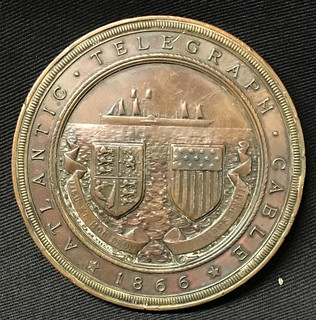
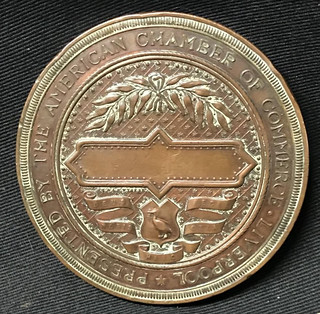
Description: Medals Maritime/Cable: Unusual bronze Transatlantic Cable medal, presented by the American Chamber of Commerce Liverpool, the obverse the SS Great Eastern is depicted with the legend Atlantic Telegraph Cable 1866. 210g. 76mm.
A nice medal commemorating one of history's great engineering achievements: the laying of the Atlantic telegraph cable which united two continents. -Editor
To read the complete lot description, see:
Lot 574: Medals Maritime/Cable: Unusual bronze Transatlantic Cable medal, presented
(https://www.invaluable.com/auction-lot/-1-c-2684757934)
1890 $5 Treasury Note
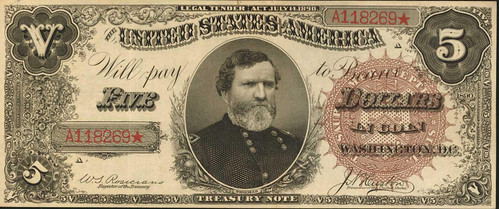
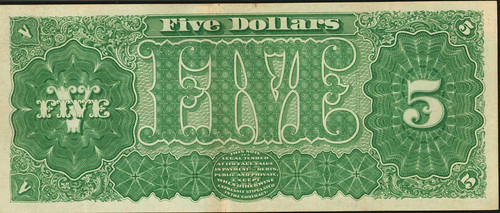
Fr. 359. 1890 $5 Treasury Note. PMG Extremely Fine 40.
The 1890 Treasury Note series has always been a banknote enthusiasts favorite as they all incorporate highly ornate design on the reverse. This piece shows with ornamental floral work and the word "FIVE" spelled in large letters. The centering is near perfect on both sides and the colors are amazing. An excellent example of this popular type note that is seldom seen in this condition.
A great note. From the Stack's Bowers November 2019 Baltimore sale. -Editor
To read the complete lot description, see:
Fr. 359. 1890 $5 Treasury Note. PMG Extremely Fine 40.
(https://auctions.stacksbowers.com/lots/view/3-KIAGK/fr-359-1890-5-treasury-note-pmg-extremely-fine-40)
1952 Studebaker Centennial Medal
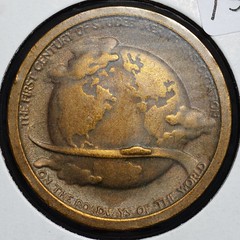
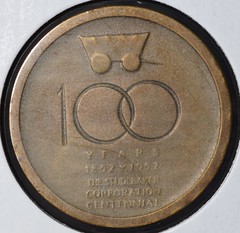
Description: Studebaker 100 year centennial commem token
I don't know about Millenials or Gen-Xers, but as a later Baby Boomer I'd heard of the Studebaker and knew it as a brand of automobile. So I was a little confused when I first saw this medal dating the founding of the Studebaker Corporation to 1852. It turns out the firm began as a blacksmith shop in South Bend, IN and later became a leading manufacturer of horse-drawn wagons, as shown on the reverse. -Editor
To read the complete lot description, see:
Lot 150: Studebaker 100 year centennial commem token
(https://www.invaluable.com/auction-lot/-1-c-045408AA14)
I found a much nicer one on eBay (it sold for $60) -Editor
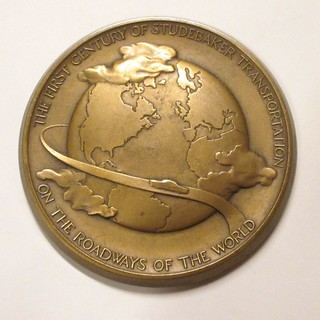
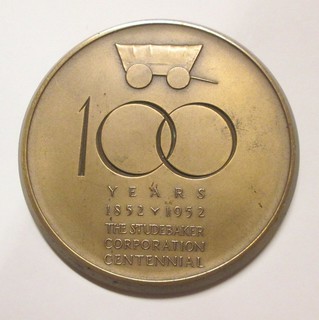
To read the complete lot description, see:
1952 Studebaker
Centennial Medallion, 3 "bronze medal - 100 years 1852 - 1952
(https://www.ebay.com/itm/1952-Studebaker-Medallon-Centenario-3-034-medalla-de-bronce-100-anos-1852-1952-/372683234733?_ul=CL&orig_cvip=true)
For more information, visit the Studebaker National Museum web site see:
https://studebakermuseum.org/

NUMISMATICS IN LIBERIA
An "O Say Can You See?" blog article from the Smithsonian National Museum of American History written by Leigh A. Gardner and Ellen Feingold of the National Numismatic Collection focuses on the numisamtics of Liberia. Here's an excerpt - be sure to see the complete article online. -Editor
Why do U.S. dollars circulate in Liberia? And how did this dual currency system emerge?
A dual currency system has existed in Liberia since the late 1800s. It can be a source of great hardship for Liberians, who might be paid in Liberian dollars but need to purchase imported food or other goods in U.S. dollars. This is particularly true when the value of the Liberian dollar falls relative to the U.S. dollar, as it has in recent years.
The Liberian dollar was created when Liberia declared independence in 1847. One of the first acts of the Liberian government was to establish its own currency—in the words of Joseph Roberts, the first president of Liberia, “to mark the existence and the nationality of the Republic.”
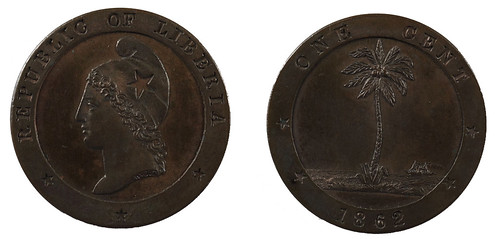
One-cent pattern coin, Republic of Liberia, 1862
The first Liberian coins tell the history of the Liberian state. One side features the image of a palm tree with a sailing ship, representing the two key sources of Liberian wealth: trade and palm oil. The other side depicts an allegorical female figure wearing what is known as a Phrygian cap or freedom cap, associated in classical imagery with formerly enslaved people.
Such a reference was particularly relevant in Liberia, which was founded in 1822 as a colony for freed African-Americans from the United States. Between 1820 and 1904, some 16,000 African-Americans migrated to Liberia. When they arrived, they found multiple currencies circulating in the region, the most important of which was the iron Kissi penny, pictured below.

Kissi penny, Liberia, 19th and 20th centuries
The American Colonization Society and its subsidiary societies, which organized the migration, also issued their own coins and notes that migrants could use at company stores for the purchase of supplies. The Liberian dollar was intended to replace these when Liberia declared itself an independent state.
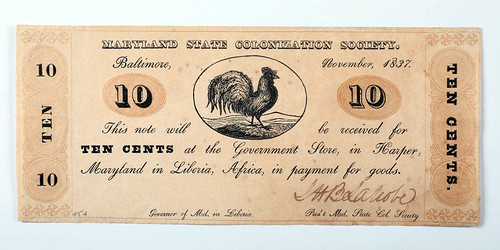
10-cent note, Maryland State Colonization Society 1837
When the Liberian dollar was issued in 1847, it had to compete not only with indigenous currencies like the Kissi penny, but also with European currencies like British pounds, shillings, and pence. The Liberian government struggled with debt throughout its early history, and one quick source of revenue was to print paper notes like this one from 1880.
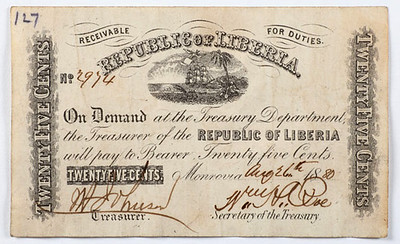
25-cent note, Republic of Liberia, 1880
To read the complete article, see:
Dollars for Donuts in Monrovia, Liberia (https://americanhistory.si.edu/blog/dollars-liberia)
OPINION: TOO MANY CHALLENGE COINS
Last December the military and veteran-focused digital media company Task & Purpose published an amusing rant complaining about the number of challenge coins issued today. I just came across it this week - here's an excerpt. -Editor
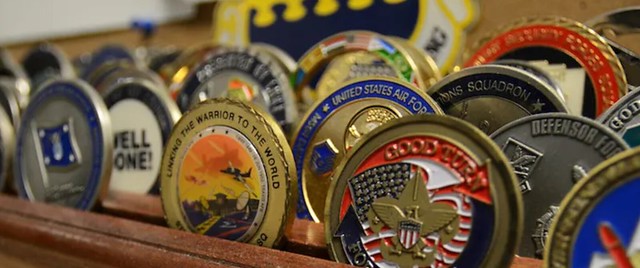
The origins of the challenge coin have been lost to antiquity. It's really anyone's guess as to how these trinkets came about.
But what isn't a guess is that the number of coins being presented today IS TOO DAMN HIGH. Just like with real money, if you make too much of it, the value goes way down. The inflation rate for challenge coins is worse than Reichsmark in Weimar Germany, and we all know how great that worked out.
Some time ago, if you got a challenge coin from a commanding officer, people thought of it as something of a score. That was before coins became like Beanie Baby collectibles for the moto set. Grown men put them in display cases, apparently under the delusion that someone, anyone, gives a shit about their hobby. Just like Beanie Babies, no one cares which ones you have or how you got them.
That's especially true now that everyone from cops to cabinet secretaries has coins. There are few things less cherished than coins from a civilian agency. Civilian coins are a tradition with about as much history and intellectual integrity as Milli Vanilli. “Oh, tell me about the fabled battle history of the Environmental Protection Agency, Mr. Secretary.”
A standard coin is now less valuable than a POG from an overseas PX. That's why so many of them have started to incorporate customized shapes and functions, usually a bottle opener. You know what also works really well as a bottle opener? A bottle opener.
The other track is to make the coin exceptionally weighty and huge. Making an otherwise perfectly ordinary item ludicrously huge is, as in most things, compensating for other shortcomings. Witness the cavalcade of faux-gold monstrosities that are the challenge coins of the Trump administration.
It's time to get a damn handle on the coin situation. There is no Federal Reserve to control the supply, so grassroots action needs to happen.
First, senior leaders need to get the hell over themselves. Unless you're a general or an admiral, you don't need a personal coin, and even then, think really hard about it. If you're a civilian and your title doesn't start with “Secretary of” and end with “Defense” or the name of a military branch, then just sit your ass down.
Somewhere between apathy and obsession is the right attitude in any endeavor. Coins are no different. Save them for when they're actually worth it, and everyone will be better off.
To read the complete article, see:
The Number Of Challenge Coins That Are Passed Out Is Too Damn High
(https://taskandpurpose.com/challenge-coins-too-damn-high/amp/)
1864 GOLD NOTRE DAME RESTORATION MEDAL OFFERED
A gold medal commemorating the 1864 restoration of the Notre Dame cathedral is being offered by Numismatica Genevensis SA. This press release describes the restoration, the medal, and fundraising efforts for the current post-fire restoration effort. -Editor
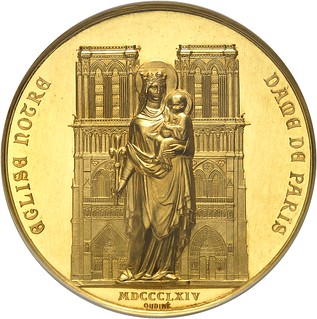
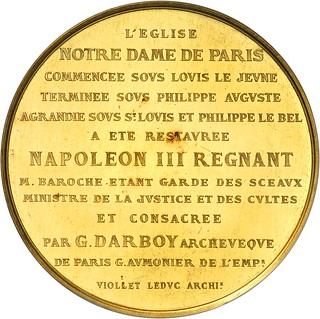
Gold medal commemorating the restoration of the cathedral Notre-Dame de Paris from 1864, made by Oudiné.
What Notre-Dame de Paris Means to Us
On 15 April 2019, the roof truss of Notre-Dame de Paris went up in flames. The entire world was watching when a major fire ate up the roof and caused the spire to collapse. Since then, the Fondation Notre Dame has been raising funds for the reconstruction works. Numismatica Genevensis wants to contribute to the reconstruction.
On 18 and 19 November 2019, Numismatica Genevensis' two auctions will be held in Geneva. Lot No. 706 is an object of particular interest. It is a gold medal minted on the occasion of completing the restoration works at Notre-Dame de Paris in 1864.
It is highly probable that the architect Viollet-le-Duc himself was awarded this medal by Napoleon III in recognition of his services. Dr Alain Baron, the founder of Numismatica Genevensis, seized this opportunity in order to help the cathedral Notre-Dame de Paris a second time by selling the medal. All commissions received from the sale of this medal – which has a starting price of CHF50,000 – will be donated to the restoration project of the Fondation Notre Dame.
Why the First Restoration of Notre-Dame Changed Our World
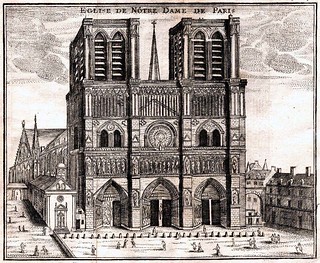 When Napoleon's reign ended, France had
to pay reparations amounting to 700 million francs. The country paid them at unprecedented speed. To be able to do so, it restructured its economy at breath-taking pace. France,
which had previously been a country mainly made up of farmers, became one of the pioneers in terms of industrialisation.
When Napoleon's reign ended, France had
to pay reparations amounting to 700 million francs. The country paid them at unprecedented speed. To be able to do so, it restructured its economy at breath-taking pace. France,
which had previously been a country mainly made up of farmers, became one of the pioneers in terms of industrialisation.
Of course, this had an impact on the large cities, especially on Paris. The amount of people moving into the city increased constantly as did the proportion of the medieval city centre disappearing in order to make room for modern tenement blocks, factory premises and administrative buildings. Parts of buildings that had been there for centuries were demolished regardless of their historical and artistic value.
On his daily promenades, the writer Victor Hugo observed how his city changed. The tower of Saint-Jacques-de-la-Boucherie housed the factory of a rifle bullet manufacturer. There were empty barrels stored in the nave of Saint-Pierre-aux-Boeufs and a theatre group was rehearsing in Saint-Benoit. Notre-Dame was in such a bad state of repair that it was planned to demolish parts of it. Horrified, Victor Hugo wrote an essay with the title “Guerre aux Démolisseurs” – without much success.
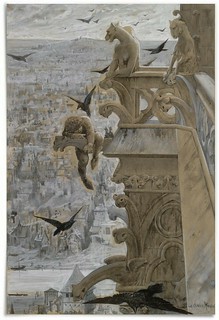 In 1828, a publisher
from Paris approached Victor Hugo and asked him to write something in the style of the extremely successful Scottish writer Walter Scott. An amazing opportunity for Hugo to win
over the broad public for his cause. Therefore, Quasimodo is not the actual hero of the novel “The Hunchback of Notre-Dame” – it is the church and the medieval city of Paris,
where the hero has to live through his adventures.
In 1828, a publisher
from Paris approached Victor Hugo and asked him to write something in the style of the extremely successful Scottish writer Walter Scott. An amazing opportunity for Hugo to win
over the broad public for his cause. Therefore, Quasimodo is not the actual hero of the novel “The Hunchback of Notre-Dame” – it is the church and the medieval city of Paris,
where the hero has to live through his adventures.
In fact, the highly successful novel managed to bring about a change in the mindset of the Parisians. They understood that the dilapidated church of Notre-Dame was something worth preserving for posterity. In 1844, it was decided to renovate the magnificent church. Whereas Georges-Eugène Haussmann was commissioned by Napoleon III to create a modern road network, the first monument men in history, Viollet-le-Duc and Prosper Mérimée, made sure that monuments worth preserving were not demolished but restored. The concept of the protection of historical monuments spread from France all over the world. We have to thank Victor Hugo, his hunchback and the first restoration of Notre-Dame de Paris for the fact that our medieval districts in Europe have not been entirely demolished to make room for modern buildings.
A Medal from 1864
In 1844, Eugéne Viollet-le-Duc presented his planning of the renovation works. The works were to cost almost 4 million francs. The politicians were shocked and cut the budget.
However, in 1850, the approved budget had been already used up even though no crucial work had been carried out by that time. All in all, the National Assembly of France had to
approve a sum of more than 12 million francs until Notre-Dame was reconstructed in the way we know it today. By the way, most of the statues stem from the 19th century. The
gargoyles with their bat wings and abhorrent faces, too, were created during the restoration carried out by Viollet-le-Duc.
In 1864, Paris celebrated the end of the renovation works. The medal offered by Numismatica Genevensis was minted on this occasion. The legend on the reverse proudly mentions all great kings responsible for the renovation works: Started under the reign of Louis the Young, completed under the rule of Philip Augustus, expanded during the reign of Saint Louis and Philip the Fair. However, the name of the emperor ruling at the time of the renovation works is written in the largest letters: Napoleon III. Together with his minister of justice and culture, Pierre Jules Baroche, he was responsible for the construction works. Notre-Dame was newly consecrated by Georges Darboy, archbishop of Paris. However, the architect was Viollet-le-Duc. By renovating the cathedral, he created an eternal monument for himself.
This Heritage Is a Responsibility
As proud as the responsible politicians might have been, Notre-Dame does not belong to them but to all French people and to the entire world. Notre-Dame symbolizes internationally
that we must protect the pieces of art that stem from our past in order to preserve them for future generations.
Numismatica Genevensis is aware of this responsibility and wants to contribute with its small donation to this great collective work. Regarding the sale, Christophe-Charles Rousselot, director of the Fondation Notre Dame, said: “Anything could happen! Imagine that the lucky buyer might donate the medal to the Cathedral Treasury Museum, which is due to reopen soon, in a gesture of benevolence and in the interests of all... This is a magnificent project which we scarcely believe possible. It is a beautiful symbol of loyalty to the history of the building and to the hopes of all to be able to enter the Cathedral again soon.”
For more information, or to bid, see:
https://www.biddr.ch/auctions/ngsa/browse?a=791&l=831961

SAVING CANADA'S VICTORIA CROSSES
This article from Canada's National Post describes the Canadian War Museum's campaign to keep in Canada Victoria Cross medals awarded to Canadians. -Editor
For Valour.
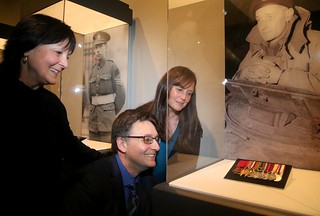 That's the simple
inscription on the Commonwealth's highest military medal, but it carries with it the weight of almost 100 stories of Canadian bravery.
That's the simple
inscription on the Commonwealth's highest military medal, but it carries with it the weight of almost 100 stories of Canadian bravery.
The Victoria Cross is not an elaborate medal. It's a simple square cross, made of a bronze alloy with a crown and a lion over the inscription. Since it was first created in 1856 it has been awarded to 99 Canadians.
The cross has been given to Canadian soldiers for sacrifices on the beaches of Dieppe, the fields of Passchendaele or at Hill 70. They were given to aviators who stayed inside burning planes to free trapped colleagues and a captain who moored his boat in a hostile harbour even as it caught fire. It has been awarded both to those who survived battles and posthumously to those who did not.
Of the 99 medals, 39 are in the hands of the Canadian War Museum and the museum wants to ensure all of the medals stay in the country and, as much as possible, are on public view.
Eric Fernberg, collections specialist at the museum, said all of the medals were awarded to men who showed remarkable bravery.
“It has always been highly regarded as the top award, because the criteria is so high and the sacrifice is so high,” he said. “They overrode all sense of self-preservation to be able to do the things that they did speaks to the individuals.”
He said the medal was also among the first gallantry awards given out regardless of rank.
“In 1856, when Queen Victoria instituted it it was her intention that it would be for everybody. It didn't matter if you were a general, a lieutenant colonel or a private. It was for everybody.”
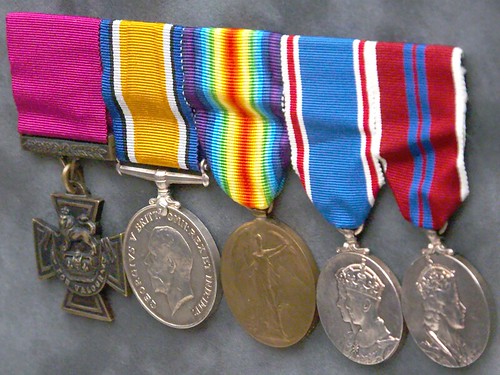
John Kinross Victoria Cross and other medals
Fernberg said because of the importance of the medal the museum does keep an eye open for any that come on the market. When sold, the medals now go for hundreds of thousands of dollars at auction.
Most are in public institutions of one kind or another, provincial museums and regimental museums. Fernberg said they know where all of the crosses are and make sure potential sellers are aware of the museum interest.
Because of their rarity, Victoria Crosses have been rising in value in recent years. The war museum doesn't discuss the prices it pays for the medals, but one of its recent purchases, the medal of Lt.-Col. David Currie, was sold for $660,000 at auction not long before the museum acquired it.
The medal was purchased by an unknown buyer, but rules against exporting cultural property prevented it from leaving Canada and the museum was able to come to terms with the auction buyer. The museum's purchase included $220,000 from a special government fund for cultural property like this and was likely close to the $660,000 paid at auction.
To read the complete article, see:
Doing right for the country: The
Canadian War Museum's mission to save Canada's Victoria Crosses
(https://nationalpost.com/news/canada/doing-right-for-the-country-the-canadian-war-museums-mission-to-save-canadas-victoria-crosses)
HOW TO STORE AND CARE FOR BOOKS SAFELY
Scott Semans writes:
I'm looking for an effective way to store books under adverse conditions, where access to the book (reading) is not a concern. My book inventory in this wet climate is subject to dampness from multiple sources, as well as occasional freezing temperatures. Controlling the atmosphere and temperature are possible, but only to a degree, and I've found I need a backup. The bags made for comics and magazines are a partial solution, but once breached, they hold in water and make the situation worse. I'm thinking in terms of the shrink wrapping publishers do, but with thicker, more temperature-resistant film. Wondering if anyone has tried this, or has a different suggestion.
Great question, and a topic we haven't discussed in some time. What do our numismatic bibliophiles recommend? Here's an article I came across this week, but it's very high-level and doesn't go into the specific question Scott raised. -Editor
Climate and Humidity
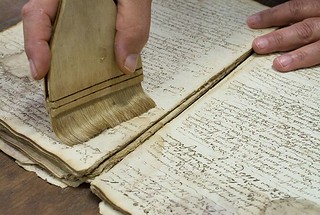 Vintage editions are especially susceptible
to minor fluctuations in temperature and humidity. To deter from disintegration or flaws in the paper or binding, keep temperatures between 65–70 degrees Fahrenheit, with humidity
levels at a steady 30–50 percent. Rooms with temperature and humidity controls are commonly used in libraries to store older artifacts, and can help preserve their condition for a
longer period of time. But if you are looking to store these items in your own home, look for rooms with minimal windows and exposure to the natural elements, and invest in a
dehumidifier to keep moisture levels at a low and constant level.
Vintage editions are especially susceptible
to minor fluctuations in temperature and humidity. To deter from disintegration or flaws in the paper or binding, keep temperatures between 65–70 degrees Fahrenheit, with humidity
levels at a steady 30–50 percent. Rooms with temperature and humidity controls are commonly used in libraries to store older artifacts, and can help preserve their condition for a
longer period of time. But if you are looking to store these items in your own home, look for rooms with minimal windows and exposure to the natural elements, and invest in a
dehumidifier to keep moisture levels at a low and constant level.
Dry heat can also become an issue, causing leather covers to crack and book glue to dry out, changing the form and appearance of rare novels. To help prevent these issues and monitor the humidity levels in your home, a hygrometer can be used to ensure ideal conditions that will keep your books in prime condition for years to come.
To read the complete article, see:
How to Store, Preserve, and Care for Rare Books
(https://www.invaluable.com/blog/how-to-preserve-rare-books/)

LOOSE CHANGE: NOVEMBER 10, 2019
Here are some additional items in the media this week that may be of interest. -Editor
The Capped Bust Half Dollar
Numismatic News published a great article by Bob Julian on the Capped Bust Half Dollar. -Editor
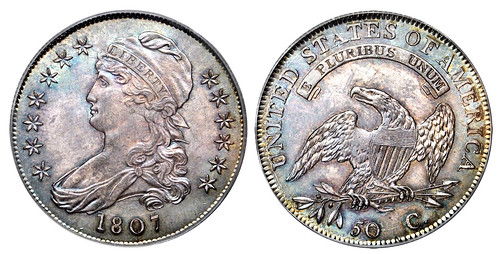
Patterson did not think that the current chief engraver, Robert Scot, was capable of executing the new artwork, so the President was asked to authorize the employment of an assistant engraver named John Reich. Patterson believed that Reich, an indentured servant freed by Chief Coiner Henry Voight, was better suited to carry out the new artistic direction on the coinage.
It was made clear to the President that Reich was wanted for the specific task of redesigning our coinage. Jefferson, of course, knew that there already was an engraver at the Mint but that he was a Federalist, and one assumes that a member of the President's political party would, of course, do a better job.
The President, whatever his views on coinage design, had very clear ideas about spending public money, and it was not until March 1807 that Director Patterson was able to persuade the Chief Executive to permit Reich to be hired as an assistant engraver at the sum of $600 per year. (Scot received $1,200 per annum). Shortly thereafter, Reich arrived at the Mint and began to prepare designs under Patterson's supervision.
To read the complete article, see:
The Capped Bust Half Dollar, 1807-1836
(https://www.numismaticnews.net/article/the-capped-bust-half-dollar-1807-1836-2)
Audio: CoinWeek Podcast with Lianna Spurrier
I listened to this one earlier this week. It's a nicely done interview with numismatic writer and videographer Lianna Spurrier, who has done such as great job on videos for the Newman Numismatic Portal this year. Check it out. -Editor
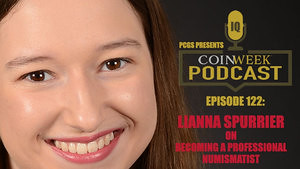 This week on the
CoinWeek Podcast, we talk to Lianna Spurrier– a numismatic writer and videographer. One of a new generation of coin professionals entering the industry. Lianna writes a column for
CoinWeek IQ and it is our pleasure to introduce you to her next… on the CoinWeek Podcast.
This week on the
CoinWeek Podcast, we talk to Lianna Spurrier– a numismatic writer and videographer. One of a new generation of coin professionals entering the industry. Lianna writes a column for
CoinWeek IQ and it is our pleasure to introduce you to her next… on the CoinWeek Podcast.
To listen to the podcast, see:
CoinWeek Podcast #122: Lianna Spurrier on Becoming a
Professional Numismatist (https://coinweek.com/coinweek-podcast/coinweek-podcast-122-lianna-spurrier-on-becoming-a-professional-numismatist/)
1923 Silver Dollar Ready to Decide Election
The flip of a 1923 silver dollar could determine the next mayor of Magnolia, OH, a small town south of Cleveland. -Editor
A coin toss will determine the winner if Boyd and Downes remain tied after election results are certified in two weeks.
That's how outgoing Mayor Robert Leach got the job, winning a coin toss in 1979. Leach chose not to seek re-election after running unopposed for 9 consecutive terms.
A 1923 Peace silver dollar is believed to have been used to break election ties in Stark County since the early 1940s.
To read the complete article, see:
Coin toss rule could determine village's tied mayoral race
(https://www.baltimoresun.com/sns-bc-oh--mayoral-tie-repeat-20191109-story.html)
Banknote Shipment Impounded in Malta
David Sundman forwarded this article from The Times about a shipment of banknotes impounded in Malta. Thanks. -Editor
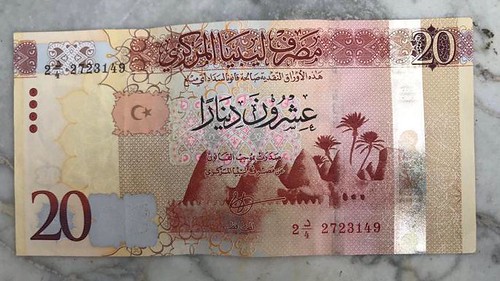
Malta has seized a massive shipment of unofficial currency believed to have been on its way from Russia to a Kremlin-backed warlord in Libya.
The money is thought to have been printed at a mint in Russia and was destined for the self-styled Marshal Khalifa Haftar, a Gaddafi-era general whose forces are attempting to overthrow the UN-backed government in Tripoli, the capital of Libya.
Two 56 cubic-metre containers packed full of the currency were confiscated in September, Maltese security services confirmed. Like most western countries, Malta recognises the government in Tripoli.
To read the complete article, see:
Money impounded on way to warlord
(https://www.thetimes.co.uk/article/money-impounded-on-way-to-warlord-7nnkmkp56?shareToken=2da52dbd9d495e1856cb127521458a72)
Russian Suspect Eats Cash with Sunflower Seeds
If a spoonful of sugar helps the medicine go down, then maybe it shouldn't be surprising to learn that a side of sunflowers makes it easier to swallow banknotes. -Editor
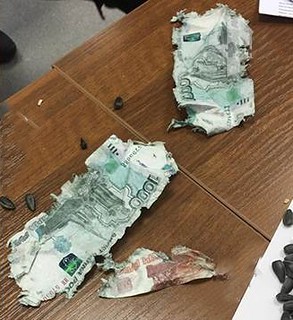 Corrupt officials around the World
have mastered the art of hiding bribe money, but a Moscow transport security officer has come up with a new, pretty unhealthy method on Wednesday when he stuffed his mouth with
banknotes and tried to swallow them as he saw police approaching his office.
Corrupt officials around the World
have mastered the art of hiding bribe money, but a Moscow transport security officer has come up with a new, pretty unhealthy method on Wednesday when he stuffed his mouth with
banknotes and tried to swallow them as he saw police approaching his office.
Major Sergei Salov of the Russian Interior Ministry's Transport Directorate for the Central Federal District, mixed banknotes worth 10,000 Russian rubles (US$156) with sunflower seeds he found in his drawer to get the bills down more easily, Crimerussia news outlet reported.
Salov reportedly managed to eat one 5,000-ruble banknote and one 1,000-ruble banknote almost completely, but could not manage the remaining four 1,000 notes.
I prefer fava beans and a nice Chianti... -Editor
To read the complete article, see:
Russia: Bribe Money with Sunflower Seeds on Menu
(https://www.occrp.org/en/27-ccwatch/cc-watch-briefs/11081-russia-bribe-money-with-sunflower-seeds-on-menu)
KING GEORGE III STATUE PART FOUND
Anne Bentley of the Massachusetts Historical Society writes:
"This is an email from a colleague, Dan Sivilich, a chemical engineer and battlefield archeologist, who was part of a team of five specialists to examine our two bullets from the Boston Massacre. He was recently involved in the project he describes below—very cool, even if not numismatic in nature, still of interest to our community I am sure."
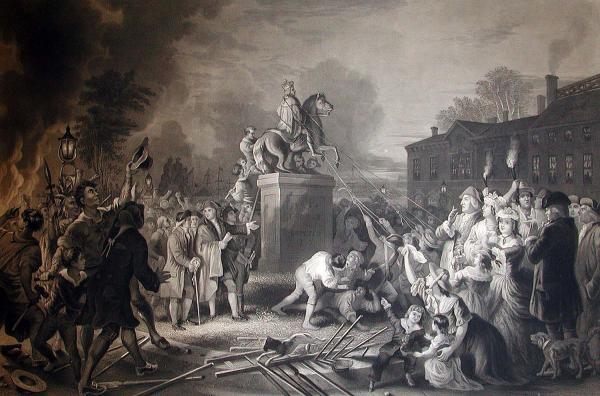
Dan Sivilich writes:
"Some time ago my good friend Joel Bohy (Skinner Auctions and Antique Roadshow) contacted me about a lead (?) hand and arm that was found in a garden in Wilton, CT. Could it be part of the famous King George III statue that was pulled down and chopped up in 1776 in the Bowling Green (lower Manhattan today) to be converted into musket balls?
"The pieces were sent to Litchfield, CT but stopped at Wilton, CT overnight. It was reported that British Loyalists stole pieces from the wagon to keep them from aiding the Americans as bullets and hid them in the nearby swamp. Over the years, several pieces were found. Six are in the New-York Historical Society. In 2014 Michael Seibert, archaeologist for the National Park Service, and I were granted permission to test 4 of the 6 pieces for their elemental content. Mike used an NPS pXRF (portable X-Ray Fluorescence) unit and he tested the pieces and subsequently tested musket balls from the Battle of Monmouth looking for matches. 9 appeared to have high probabilities for being from the statue, but that is a different story.
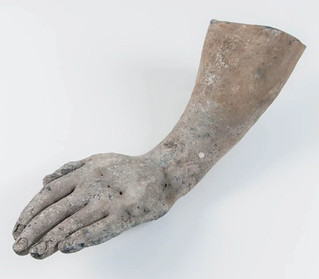 "So back to the hand ... Joel
sent the piece to Dan Elliot (another friend of mine) of the Lamar Institute for pXRF testing. Dan sent me the results which I compared to the data of the two larger N-YHS statue
pieces. It looked like a near perfect match. To be sure, I sent both sets of data to another friend, Bruce Kaiser, inventor of the Bruker pXRF. He agreed that it was a match. The
hand/arm had the same elemental composition as the statue. Coupling this with the fact that it was found in an 18th Century house that was once owned by a British Loyalist in the
same town as the wagon spent the night, SLAM DUNK!
"So back to the hand ... Joel
sent the piece to Dan Elliot (another friend of mine) of the Lamar Institute for pXRF testing. Dan sent me the results which I compared to the data of the two larger N-YHS statue
pieces. It looked like a near perfect match. To be sure, I sent both sets of data to another friend, Bruce Kaiser, inventor of the Bruker pXRF. He agreed that it was a match. The
hand/arm had the same elemental composition as the statue. Coupling this with the fact that it was found in an 18th Century house that was once owned by a British Loyalist in the
same town as the wagon spent the night, SLAM DUNK!
"I was sworn to secrecy about the project but Skinner auctioned the piece off on Monday. It was first listed as estimated to bring $5,000 - $10,000. That was later changed
to $15,000 - $20,000. Here is the link to what it actually sold for:"
Lead Hand, Wrist, and Forearm Likely from the Statue of King George III at Bowling Green, New York City
(https://www.skinnerinc.com/auctions/3305M/lots/204)
Very cool find! Not something one would expect to come out of the woodwork in 2019. -Editor
For more information, see:
Pulling Down the Statue of George III
(http://www.teachushistory.org/american-revolution/resources/pulling-down-statue-george-iii)
THE STATUE OF GEORGE III (https://allthingsliberty.com/2014/09/the-statue-of-george-iii/)

